#a parade of providence: act ii
Text
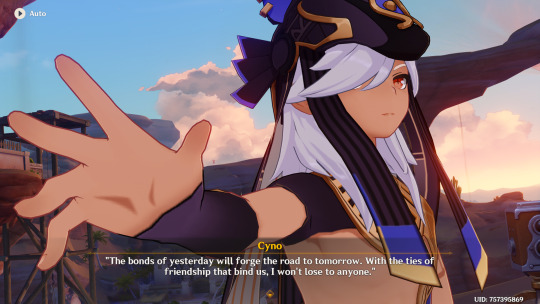


he's such a dork, what a total nerd, truly a loser (affectionate)

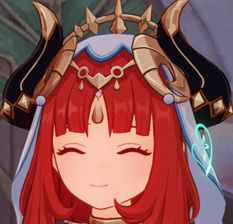
i think their faces summon up this entire exchange quite well
#genshin impact#a parade of providence: act ii#a parade of providence#cyno#alhaitham#nilou#mine.#nilou looks like those parents that dont understand their child but encourage their ramblings#alhaitham just looks done and is trying very hard to project himself away from the happening#my heart grows like three sizes for all of them
37 notes
·
View notes
Text
Quest-Related Content
Chapter I Act IV Prelude: Bough Keeper Dainsleif
Chapter I Act IV: We Will Be Reunited (extra)
Version 1.5: Beneath the Light of Jadeite (Zhongli Story Quest II, Teapot quest)
Bennett and Barbara hangouts, other misc doodles
Chapter II Prologue: Autumn Winds, Scarlet Leaves (and other 1.6 content)
Chapter II Act I and II, Yoimiya and Ayaka Story Quests
Version 2.1: Chapter II Act III (Trailer, Omnipresence Over Mortals) and Raiden Shogun Story Quest I, Kokomi Story Quest
Version 2.2: Labyrinth Warriors
Version 2.3: Shadows Amidst Snowstorms (Trailer, Quest) and Arataki Itto Story Quest (extra Itto doodles)
Interlude Chapter Act I: The Crane Returns on the Wind
Chapter II Act IV: Requiem of the Echoing Depths
Interlude Chapter Act II: Perilous Trail (pre-release cowabunga)(quest summary)(alt ending animatic)(childe moment)
Chapter III Act I and II
Version 3.1: Pre-release anti-gap-moe + aranyaka, Chapter III Act III and IV, SCREW TIRZAD
Version 3.2: Pre-release scara drip, Chapter III Act V
Interlude Chapter Act III: Inversion of Genesis
Version 3.4: Al-Haitham demo, Desert World Quest 2
Chapter III Act VI
Version 3.5: Windblume's Breath
Version 3.6: A Parade of Providence
Chapter IV Act I and II
Chapter IV Act III and IV
Version 4.2: Furina demo, Chapter IV Act V
#holy moly this was a doozy#I think i really found my stride post-omnipresence over mortals#that's when the jokes got funnier. and more structured generally#I'll link to this in the pinned post (u_u)b
405 notes
·
View notes
Text

Welcome to the community bulletin board! Here are some events happening around the Boroughs this month:
March 2-3: Women's History Month Trivia at The Corner Pub, Brooklyn
March 6: Free Mini Scoops* at Freshly Churned, Staten Island
March 14: National Pi Day at the Diner, the Bronx
March 16: St. Patrick's Day Parade, Manhattan
March 19: Volunteer Spring Cleaning at the Bronx River, the Bronx
March 25: Holi Celebration at Prospect Park, Brooklyn & Club 51, Manhattan
March 30: Beyoncé Night at Cowbells, The Bronx
March 31: Easter Egg Hunt at Socrates Sculpture Park, Queens
Continue reading below to find descriptive blurbs of each event. As a reminder, community events are optional events for members to use during their threads throughout the month of March.
March 2-3: Women History Month Trivia at The Corner Pub, Brooklyn
It's International Women's Month! To kick off the celebration, the weekend trivia topics for the first weekend of March at the Corner Pub will be all about the historical women who've helped fight for women's rights throughout the world.
March 6th: Free Mini Scoops* at Freshly Churned, Staten Island
In celebration of National Oreo Cookie Day and National White Chocolate Cheesecake Day, Freshly Churned have turned both delicious flavors into their own ice cream at the parlor, and patrons can have a complimentary mini scoop of each to boot!
March 14: National Pi Day at the Diner, the Bronx
For one day and one day only, all pies at the Diner will be priced at $3.14, in honor of pi day. Do not try to talk mathematics with the owner - they're doing this because they think the idea is quirky, not for any fondness towards the subject.
March 16: St. Patrick's Day Parade, Manhattan
The annual St. Patrick's Day parade returns this year to Midtown Manhattan! Starting promptly at 11am and ending around 4:30pm, stop by and observe a spectacle of Irish culture!
March 19: Volunteer Spring Cleaning at the Bronx River, the Bronx
It's the first day of Spring! What better way to celebrate than with a little bit of spring cleaning? Join the Bronx River Association as they steward and keep the river clean. Trash collecting tools and gloves will be provided to volunteers upon arrival.
March 25: Holi Celebration at Prospect Park, Brooklyn // Holi Part at Club 51, Manhattan
The family friendly version of the event will take place in Brooklyn, where guests of all ages are welcome to come dressed in white and have fun partaking in the colorful holiday festivities associated with Holi. As the night approaches, adults can keep the party going over at Club 51, where the Main Room will be pumping Bollywood hits while the staff hands out paints and glow sticks to celebrate!
March 30: Beyoncé Night at Cowbells, the Bronx
Beyhive fans will only have one day to study the lyrics of Beyoncé's recently released Act II in preparation of Beyoncé night at Cowbells! Act II will be on rotation all night long, along with other hits from Beyoncé's extensive catalog, in order to ring in her new era of music.
March 31: Easter Egg Hunt at Socrates Sculpture Park, Queens
Sponsored by local religious organizations, a large, free Easter Egg hunt will take place at the Socrates Sculpture Park in Queens at 11am. While directly targeted towards kids, guests of all ages (and all religions) are free to attend and hunt for eggs! Rumor has it thousands of eggs have been scattered all around the park by local volunteers, with the sculptures providing some interesting hiding spots.
Admin Note: The above events are all optional events that members are free to use as the setting for threads throughout the month of March. Though each event comes with brief descriptions, writers are free to manipulate and take liberties with them however they like for their threads. Additionally, writers are not restricted to only writing threads on the dates of the events listed; you are free to create threads around these events and post them whenever you like during the month of March.
9 notes
·
View notes
Text
A Parade of Providence Act II
This part was very interesting!

This scene between Laila and Kaveh at the beginning was relatable to me. I’m constantly overthinking stuff, and I also have trouble sleeping the night before a big event. So I relate to both of them in that aspect.
Especially Kaveh’s problems in this trial, where he kept been distracted. If I see those poor animals, I’d also give them food and try to help them. Yeah, that may make me lose but I can’t ignore it either! He’s honestly too nice of a person.

I like this artworks we’re getting in the event, they remind me of the Hangout endings. Of course Kuni is insulting people while also helping them, honestly Paimon should get used to it lol

Was I supposed to know that Laila had a different personality? lol. I haven’t done her Hangout yet so maybe it’s revealed in there. It was kind of a surprise but makes sense I guess, with her sleeping theming.
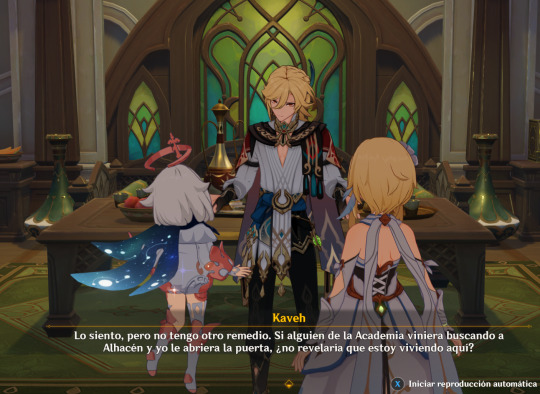
It wouldn’t be a Genshin event if we don’t have some kind of secondary plot would it? At least it’s an excuse to come to Alhaitham’s house again. Honestly it’s funny seeing the difference between Nice Kaveh and Annoyed Kaveh lol he gets so offended by Alhaitham.
I’ll continue with the finale soon and finish the minigames as well.
7 notes
·
View notes
Text
by context (archon quest/version patch)
Master list by archon quest and version patch. Since story quests usually pertain to the specific character, please use the character navigation for those.
by archon quest
All tagged under #archon quest
Prologue: The Outlander who Caught the Wind
Chapter I: Farewell Archaic Lord
Chapter II: Omnipresence Over Mortals
Chapter III: Truth Amongst the Pages of Purana
Chapter IV: Masquerade of the Guilty
Interlude, Act 1: The Crane Returns on the Wind
Interlude, Act 2: Perilous Trail
Interlude, Act 3: Inversion of Genesis
Traveler Quest (focus on the Twins and Dainsleif)
by version patch
All tagged under #version X.X
4.6 Two Worlds Aflame, the Crimson Night Fades
4.5 Blades Weaving Betwixt Brocade
4.4 Vibrant Harriers Aloft in Spring Breeze
4.3 Roses and Muskets
4.2 Masquerade of the Guilty
4.1 To the Stars Shining in the Depths
4.0 As Light Rain Falls Without Reason
3.8 Secret Summer Paradise
3.7 Duel! The Summoners’ Summit!
3.6 A Parade of Providence
3.5 Windblume’s Breath
3.4 The Exquisite Night Chimes
3.3 All Senses Clear, all Existence Void
3.2 Akasha Pulses, the Kalpa Flame Rises
3.1 King Deshret and the Three Magi
3.0 The Morn a Thousand Roses Brings
2.8 Summer Fantasia
2.7 Hidden Dreams in the Depths
2.6 Zephyr of the Violet Garden
2.5 When the Sakura Bloom
2.4 Fleeting Colors in Flight
2.3 Shadows Amidst Snowstorms
2.2 Into the Perilous Labyrinth of Fog
2.1 Floating World Under the Moonlight
2.0 The Immovable God and the Eternal Euthymia
1.6 Midsummer Island Adventure
1.5 Beneath the Light of Jadeite
1.4 Invitation of Windbloom
1.3 All That Glitters
1.2 The Chalk Prince and the Dragon
1.1 A New Star Approaches
1 note
·
View note
Text
LUIGI CHERUBINI'S MÉDÉE AT LA SCALA, JANUARY 26, 2024
Corinth, time out of mind. Preparations are under way for the big wedding: Créon’s daughter, Dircé, is going to marry Jason. Jason is a celebrated hero (he’s just managed to steal the Golden Fleece together with the Argonauts and everything), but he’s also carrying about two children from his previous marriage with Médée, a powerful sorceress whom he abandoned/repudiated like, seconds ago. So the thought of Médée’s inevitable anger (1), the presence of Médée’s children (2), and possibly Jason’s own unextinguished feelings for Médée (3) are tormenting Dircé more and more. (I made it a numbered list for the sake of clarity. I’d say [3] is harrowing Dircé the most). Then, out of the blue and to everyone’s astonishment, Médée herself makes her entrance. Then, moments of sheer terror; suspicion; tentative steps… How will everything turn out in the end? As far as my experience on the ground is concerned, there’s a lone crucial piece of information I need to share: this Médée as a whole was downright amazing. You should find a way to catch it live someday—either at La Scala or elsewhere (provided a revival is in the cards). That’s it. The rest is… details? It all started with director Damiano Michieletto’s subtle, crafty, and positively riveting approach. The spoken dialogue—specifically rewritten for this production by Mattia Palma—was entirely given to Médée’s children (who are non-speaking characters in the original libretto). While the content was deliberately plain and unshowy, the way those lines were delivered was revealing. It was a series of short, recorded voice-over segments; whispered, yet robustly amplified. There was a strong The Turn of the Screw vibe. (A mirror image: Miles is older than his sister Flora; it was the other way round here). I was like, OK, this is a ghost story—and that became the key to, well, everything else. First and foremost, it was a perfect match for Luigi Cherubini’s extraordinary score (and for what Michele Gamba and the orchestra were doing from the outset, as well).
It was essentially a slow-moving, austere ritual parade of eerie melodies—each of those melodies pushing further and further into a blurry area where ordinary humans and ghosts aren’t that dissimilar anymore. The masterful use of dotted rhythms (which have been an emblem of the supernatural in music for centuries) was especially prominent. And there was a great deal of variety. The Ouverture—far away; somewhat dry and thin—seemed to be coming from a vintage (and maybe haunted) transistor radio. Yet much wider, heavier waves of sound were available when needed (no doubt for the thunderstorm lashing at Corinth at the beginning of Act III, and for the very finale). As a general outcome, this Médée made me think of some perfectly intact burial chamber from, say, the Old Kingdom of Egypt: a miniature replica of the world, a fictional underground environment where the soul of a single person—in this case, Médée—can relive the truly essential parts of its earthly journey, in order to be able to cross over into the afterlife. I also wish to put on record that Dircé—as portrayed, with lots of introspection and nuances, by Martina Russomanno—was an interesting character: she’s another Médée, virtually identical, only at a different stage of her life. Her extended aria with obbligato flute «Hymen! Viens dissiper une vaine frayeur» (Act I) came off as an absolute showstopper. (Another aria with an obbligato instrument [this time, a mesmerizing bassoon] was nothing short of memorable: «Ah! Nos peines seront communes», sung by Ambroisine Bré as Néris [Médée’s slave] in the middle of Act II). Finally, Marina Rebeka’s Médée… it’s complicated. It started out as a wonderful performance: unpredictable, multi-layered, genuinely creepy… I was loving every tiny bit of it. But it was cut short at the end of Act I; due to illness, Claire de Monteil had to step in for Act II and Act III. It’s not like I didn’t appreciate Claire de Monteil’s singing style or something. It’s more of, I couldn’t overcome the interruption. My Médée was Marina Rebeka. It was fixed by then; my imagination wouldn’t make any switch from that. That’s one reason why I’m already waiting for this specific Médée to somehow come back.
1 note
·
View note
Text
A Look At How Cherry Blossom Trees Became A Symbol Of Spring—And Friendship—In The Capital
WASHINGTON, DC - MARCH 27: Cherry blossoms bloom on the grounds of the U.S. Capitol on March 27, ... [+] 2023 in Washington, DC. (Photo by Anna Moneymaker/Getty Images)
Getty Images
Few things herald the coming of spring in the United States like the blooming of the cherry blossom trees around the Tidal Basin in Washington, D.C.
Although the National Park Service has deemed March 23, 2023, as "peak bloom" for the blossoms, March 27 is a bit more significant: It was on this day in 1912 that Helen Taft, wife of President William Taft, and the Viscountess Chinda, wife of the Japanese ambassador, planted two Yoshino cherry trees on the northern bank of the Potomac River near the Jefferson Memorial. The event was meant to celebrate what we become an iconic gift from the Japanese government of 3,020 cherry trees to the U.S. government.
D.C. Cherry Blossom Tree History
This wasn't the first significant appearance of Japanese cherry trees in D.C. In January 1910, 2,000 trees arrived from Japan, but they were infested with insects and nematodes, and were diseased. As a result, they had to be destroyed.
The mayor of Tokyo, Yukio Ozaki, and others suggested a second donation, and those were shipped out in 1912. Of the 3,020 trees, more than half were Yoshino cherry trees. Two were planted along the Tidal Basin in a formal ceremony, while the rest were homed along the basin, in East Potomac Park, and on the White House grounds.
The trees proved to be very popular with visitors, who flocked to see the pink and white blossoms. In 1935, D.C. celebrated its first “Cherry Blossom Festival” which eventually became an annual event.
Miss America 1964, Donna Axum, waves from a convertible in the National Cherry Blossom Festival ... [+] 'Parade of Princesses,' Washington DC, April 11, 1965. (Photo by PhotoQuest/Getty Images)
Getty Images
MORE FROMFORBES ADVISOR
After World War II, the famed cherry tree grove along the Arakawa River near Tokyo—the parent stock for Washington D.C.'s first trees—had fallen into disrepair. The National Park Service shipped budwood from descendants of those same trees back to Tokyo to help restore the original grove.
More than a decade later, in 1965, Japan would return the favor by gifting 3,800 Yoshino trees. First Lady Lady Bird Johnson, wife of President Lyndon Baines Johnson, and Ryuji Takeuchi, wife of Japan's Ambassador, reenacted the famous planting ceremony of 1912. Many of these trees were planted on the grounds of the Washington Monument.
Today, the cherry blossom trees are a symbol of continued friendship between the two countries.
Caring For The Trees
To ensure the health of the trees, the National Mall and Memorial Parks (NAMA) Division of the National Park Service employees a small team. They work to care not only for the nearly 4,000 cherry blossom trees, but also the more than 20,000+ trees on the 1,100 acres making up National Mall and Memorial Parks.
National Park Service
The National Park Service was created by the Organic Act of 1916 “to conserve the scenery and the natural and historic objects and the wildlife therein and to provide for the enjoyment of the same in such manner and by such means as will leave them unimpaired for the enjoyment of future generations.”
The NPS covers over 85 million acres, including 136 historical parks or sites, 84 national monuments, 63 national parks, 31 national memorials, 25 battlefields or military parks, and 84 otherwise designated national park units. In 2021, 297 million visitors stopped by an NPS site. Before Covid, park visitation routinely exceeded 300 million.
Funding
The NPS is primarily funded by Congress—in 2023, the budget request was for $3 .1 billion for operations of the national park system. The agency also receives funding through park entrance, user fees, and private philanthropy.
WASHINGTON, DC - APRIL 28: Actress Bellamy Young speaks at the Trust for the National Mall's Ninth ... [+] Annual Benefit Luncheon in West Potomac Park on April 28, 2016 in Washington, DC. (Photo by Paul Morigi/Getty Images)
Getty Images
One of those philanthropic sources is the Trust for the National Mall, the non-profit partner of the National Park Service on the National Mall. According to Julie Moore, Vice President of Communications for Trust for the National Mall, their mission is to help restore, preserve, and enrich the National Mall. Preserving and protecting the 3,700 cherry trees on the National Mall is an essential part of that work and mission.
The Trust is currently raising money through its Adopt-A-Cherry Tree program. The program is the primary source of private funding for the care and maintenance of the cherry trees. According to Moore, it costs approximately $1,000 to endow a tree throughout its lifetime, including acquiring and planting a young sapling, pruning, feeding, and watering.
Today, the famed cherry blossom trees are facing challenges, including a changing climate and advanced age—remember, they're more than 100 years old. And with more than 1.5 million visitors breezing by the trees each year, celebrating the springtime blooms has become a tradition in the nation's capital.
(Can't make it to D.C.? You can keep tabs on the trees via the Bloomcam. Full disclosure: It's addictive.)
WASHINGTON D.C., UNITED STATES - MARCH 26: Cherry blossoms are in bloom around the Tidal Basin ... [+] during 'National Cherry Blossom Festival ' at National Mall on March 26, 2023 in Washington, DC, United States. (Photo by Rabia Iclal Turan/Anadolu Agency via Getty Images)
Anadolu Agency via Getty Images
The Trust has set a goal of raising $3.7 million to protect the cherry trees on the National Mall. So far, they've raised nearly $500,000 to plant new saplings and care for the trees. The aim, says Moore, is to make sure the iconic cherry trees bloom for generations to come.
Read more here https://fx7.s3-web.au-syd.cloud-object-storage.appdomain.cloud/us-taxation/US-Tax/International-Taxation-for-US-Expats-How-to-Deal-With-Capital-Gains-Tax.html
0 notes
Text
A Look At How Cherry Blossom Trees Became A Symbol Of Spring—And Friendship—In The Capital
WASHINGTON, DC - MARCH 27: Cherry blossoms bloom on the grounds of the U.S. Capitol on March 27, ... [+] 2023 in Washington, DC. (Photo by Anna Moneymaker/Getty Images)
Getty Images
Few things herald the coming of spring in the United States like the blooming of the cherry blossom trees around the Tidal Basin in Washington, D.C.
Although the National Park Service has deemed March 23, 2023, as "peak bloom" for the blossoms, March 27 is a bit more significant: It was on this day in 1912 that Helen Taft, wife of President William Taft, and the Viscountess Chinda, wife of the Japanese ambassador, planted two Yoshino cherry trees on the northern bank of the Potomac River near the Jefferson Memorial. The event was meant to celebrate what we become an iconic gift from the Japanese government of 3,020 cherry trees to the U.S. government.
D.C. Cherry Blossom Tree History
This wasn't the first significant appearance of Japanese cherry trees in D.C. In January 1910, 2,000 trees arrived from Japan, but they were infested with insects and nematodes, and were diseased. As a result, they had to be destroyed.
The mayor of Tokyo, Yukio Ozaki, and others suggested a second donation, and those were shipped out in 1912. Of the 3,020 trees, more than half were Yoshino cherry trees. Two were planted along the Tidal Basin in a formal ceremony, while the rest were homed along the basin, in East Potomac Park, and on the White House grounds.
The trees proved to be very popular with visitors, who flocked to see the pink and white blossoms. In 1935, D.C. celebrated its first “Cherry Blossom Festival” which eventually became an annual event.
Miss America 1964, Donna Axum, waves from a convertible in the National Cherry Blossom Festival ... [+] 'Parade of Princesses,' Washington DC, April 11, 1965. (Photo by PhotoQuest/Getty Images)
Getty Images
MORE FROMFORBES ADVISOR
After World War II, the famed cherry tree grove along the Arakawa River near Tokyo—the parent stock for Washington D.C.'s first trees—had fallen into disrepair. The National Park Service shipped budwood from descendants of those same trees back to Tokyo to help restore the original grove.
More than a decade later, in 1965, Japan would return the favor by gifting 3,800 Yoshino trees. First Lady Lady Bird Johnson, wife of President Lyndon Baines Johnson, and Ryuji Takeuchi, wife of Japan's Ambassador, reenacted the famous planting ceremony of 1912. Many of these trees were planted on the grounds of the Washington Monument.
Today, the cherry blossom trees are a symbol of continued friendship between the two countries.
Caring For The Trees
To ensure the health of the trees, the National Mall and Memorial Parks (NAMA) Division of the National Park Service employees a small team. They work to care not only for the nearly 4,000 cherry blossom trees, but also the more than 20,000+ trees on the 1,100 acres making up National Mall and Memorial Parks.
National Park Service
The National Park Service was created by the Organic Act of 1916 “to conserve the scenery and the natural and historic objects and the wildlife therein and to provide for the enjoyment of the same in such manner and by such means as will leave them unimpaired for the enjoyment of future generations.”
The NPS covers over 85 million acres, including 136 historical parks or sites, 84 national monuments, 63 national parks, 31 national memorials, 25 battlefields or military parks, and 84 otherwise designated national park units. In 2021, 297 million visitors stopped by an NPS site. Before Covid, park visitation routinely exceeded 300 million.
Funding
The NPS is primarily funded by Congress—in 2023, the budget request was for $3 .1 billion for operations of the national park system. The agency also receives funding through park entrance, user fees, and private philanthropy.
WASHINGTON, DC - APRIL 28: Actress Bellamy Young speaks at the Trust for the National Mall's Ninth ... [+] Annual Benefit Luncheon in West Potomac Park on April 28, 2016 in Washington, DC. (Photo by Paul Morigi/Getty Images)
Getty Images
One of those philanthropic sources is the Trust for the National Mall, the non-profit partner of the National Park Service on the National Mall. According to Julie Moore, Vice President of Communications for Trust for the National Mall, their mission is to help restore, preserve, and enrich the National Mall. Preserving and protecting the 3,700 cherry trees on the National Mall is an essential part of that work and mission.
The Trust is currently raising money through its Adopt-A-Cherry Tree program. The program is the primary source of private funding for the care and maintenance of the cherry trees. According to Moore, it costs approximately $1,000 to endow a tree throughout its lifetime, including acquiring and planting a young sapling, pruning, feeding, and watering.
Today, the famed cherry blossom trees are facing challenges, including a changing climate and advanced age—remember, they're more than 100 years old. And with more than 1.5 million visitors breezing by the trees each year, celebrating the springtime blooms has become a tradition in the nation's capital.
(Can't make it to D.C.? You can keep tabs on the trees via the Bloomcam. Full disclosure: It's addictive.)
WASHINGTON D.C., UNITED STATES - MARCH 26: Cherry blossoms are in bloom around the Tidal Basin ... [+] during 'National Cherry Blossom Festival ' at National Mall on March 26, 2023 in Washington, DC, United States. (Photo by Rabia Iclal Turan/Anadolu Agency via Getty Images)
Anadolu Agency via Getty Images
The Trust has set a goal of raising $3.7 million to protect the cherry trees on the National Mall. So far, they've raised nearly $500,000 to plant new saplings and care for the trees. The aim, says Moore, is to make sure the iconic cherry trees bloom for generations to come.
Read more here https://fx7.s3-web.au-syd.cloud-object-storage.appdomain.cloud/us-taxation/US-Tax/International-Taxation-for-US-Expats-How-to-Deal-With-Capital-Gains-Tax.html
0 notes
Text
A Look At How Cherry Blossom Trees Became A Symbol Of Spring—And Friendship—In The Capital
WASHINGTON, DC - MARCH 27: Cherry blossoms bloom on the grounds of the U.S. Capitol on March 27, ... [+] 2023 in Washington, DC. (Photo by Anna Moneymaker/Getty Images)
Getty Images
Few things herald the coming of spring in the United States like the blooming of the cherry blossom trees around the Tidal Basin in Washington, D.C.
Although the National Park Service has deemed March 23, 2023, as "peak bloom" for the blossoms, March 27 is a bit more significant: It was on this day in 1912 that Helen Taft, wife of President William Taft, and the Viscountess Chinda, wife of the Japanese ambassador, planted two Yoshino cherry trees on the northern bank of the Potomac River near the Jefferson Memorial. The event was meant to celebrate what we become an iconic gift from the Japanese government of 3,020 cherry trees to the U.S. government.
D.C. Cherry Blossom Tree History
This wasn't the first significant appearance of Japanese cherry trees in D.C. In January 1910, 2,000 trees arrived from Japan, but they were infested with insects and nematodes, and were diseased. As a result, they had to be destroyed.
The mayor of Tokyo, Yukio Ozaki, and others suggested a second donation, and those were shipped out in 1912. Of the 3,020 trees, more than half were Yoshino cherry trees. Two were planted along the Tidal Basin in a formal ceremony, while the rest were homed along the basin, in East Potomac Park, and on the White House grounds.
The trees proved to be very popular with visitors, who flocked to see the pink and white blossoms. In 1935, D.C. celebrated its first “Cherry Blossom Festival” which eventually became an annual event.
Miss America 1964, Donna Axum, waves from a convertible in the National Cherry Blossom Festival ... [+] 'Parade of Princesses,' Washington DC, April 11, 1965. (Photo by PhotoQuest/Getty Images)
Getty Images
MORE FROMFORBES ADVISOR
After World War II, the famed cherry tree grove along the Arakawa River near Tokyo—the parent stock for Washington D.C.'s first trees—had fallen into disrepair. The National Park Service shipped budwood from descendants of those same trees back to Tokyo to help restore the original grove.
More than a decade later, in 1965, Japan would return the favor by gifting 3,800 Yoshino trees. First Lady Lady Bird Johnson, wife of President Lyndon Baines Johnson, and Ryuji Takeuchi, wife of Japan's Ambassador, reenacted the famous planting ceremony of 1912. Many of these trees were planted on the grounds of the Washington Monument.
Today, the cherry blossom trees are a symbol of continued friendship between the two countries.
Caring For The Trees
To ensure the health of the trees, the National Mall and Memorial Parks (NAMA) Division of the National Park Service employees a small team. They work to care not only for the nearly 4,000 cherry blossom trees, but also the more than 20,000+ trees on the 1,100 acres making up National Mall and Memorial Parks.
National Park Service
The National Park Service was created by the Organic Act of 1916 “to conserve the scenery and the natural and historic objects and the wildlife therein and to provide for the enjoyment of the same in such manner and by such means as will leave them unimpaired for the enjoyment of future generations.”
The NPS covers over 85 million acres, including 136 historical parks or sites, 84 national monuments, 63 national parks, 31 national memorials, 25 battlefields or military parks, and 84 otherwise designated national park units. In 2021, 297 million visitors stopped by an NPS site. Before Covid, park visitation routinely exceeded 300 million.
Funding
The NPS is primarily funded by Congress—in 2023, the budget request was for $3 .1 billion for operations of the national park system. The agency also receives funding through park entrance, user fees, and private philanthropy.
WASHINGTON, DC - APRIL 28: Actress Bellamy Young speaks at the Trust for the National Mall's Ninth ... [+] Annual Benefit Luncheon in West Potomac Park on April 28, 2016 in Washington, DC. (Photo by Paul Morigi/Getty Images)
Getty Images
One of those philanthropic sources is the Trust for the National Mall, the non-profit partner of the National Park Service on the National Mall. According to Julie Moore, Vice President of Communications for Trust for the National Mall, their mission is to help restore, preserve, and enrich the National Mall. Preserving and protecting the 3,700 cherry trees on the National Mall is an essential part of that work and mission.
The Trust is currently raising money through its Adopt-A-Cherry Tree program. The program is the primary source of private funding for the care and maintenance of the cherry trees. According to Moore, it costs approximately $1,000 to endow a tree throughout its lifetime, including acquiring and planting a young sapling, pruning, feeding, and watering.
Today, the famed cherry blossom trees are facing challenges, including a changing climate and advanced age—remember, they're more than 100 years old. And with more than 1.5 million visitors breezing by the trees each year, celebrating the springtime blooms has become a tradition in the nation's capital.
(Can't make it to D.C.? You can keep tabs on the trees via the Bloomcam. Full disclosure: It's addictive.)
WASHINGTON D.C., UNITED STATES - MARCH 26: Cherry blossoms are in bloom around the Tidal Basin ... [+] during 'National Cherry Blossom Festival ' at National Mall on March 26, 2023 in Washington, DC, United States. (Photo by Rabia Iclal Turan/Anadolu Agency via Getty Images)
Anadolu Agency via Getty Images
The Trust has set a goal of raising $3.7 million to protect the cherry trees on the National Mall. So far, they've raised nearly $500,000 to plant new saplings and care for the trees. The aim, says Moore, is to make sure the iconic cherry trees bloom for generations to come.
Read more here https://fx7.s3-web.au-syd.cloud-object-storage.appdomain.cloud/us-taxation/US-Tax/International-Taxation-for-US-Expats-How-to-Deal-With-Capital-Gains-Tax.html
0 notes
Text
‘THE DREAM PARADE’ ( FULL LENGTH VERSION ) ( 2010 )
‘THE DREAM PARADE’
On this collection I wanted to focus on the of subject of relationships in the modern age, how they are affected by the ripple effects of larger events. I also wanted to use a fantastical element to write about these things, blend these two separate elements into a complete whole if possible.
It was intended to be the lyrics for a rock opera from its conception. It tells the story of a central character, Johnny, who after losing his job, fears he is losing his wife and family as well. Somehow he begins to hear their dreams like radio signals, then eventually he begins to hear the whole world.
On quite a few occasions throughout the writing of this collection I found I had no idea how to achieve what I was after, and for that matter quite what I was after. So on most of the lyrics I just sat down and wrote until they began to shape themselves and gain their own unique tone and themes. I’m still not sure if I achieved what I set out to do but I’m proud of the finished result.
Perhaps flawed ambition is better than no ambition at all? …
Hope you enjoy
James Ellis
ACT I
01. NOBODY’S SON ( DEAD TO THE
WORLD )
02. OH, MOTHER DEAREST
03. WAVES CRASH
IN
04. IN EVERY DREAM A HEARTACHE
05. THE PILOT’S DREAM
06. HEAVEN WILL
WAIT
07. THE DREAM PARADE
( PART I )
ACT II
08. NOBODY’S SON ( TIME TO
WAKE UP )
09. UP AGAINST THE
WALL
10. RADIO DREAMING
( WHITE NOISE )
11. WILL THERE BE A
LIGHT?
12. WAVES CRASH IN ( REPRISE )
13. END OF OUR
DAYS
14. THE DREAM PARADE
( PART II )
July 2010 - September
2010
01. NOBODY’S SON ( DEAD TO THE WORLD )
( Sound of a factory siren blaring out/ sound of footfalls and metal gates being closed… )
( Burst of static/ tuning of a radio… )
( Male radio announcer: “… closed its gates for the final time today after seventy eight years of business. Over six hundred workers lost their jobs when…” )
( burst of static/ tuning of a radio… )
Johnny, gotta be tough to get through
the hard
times
Johnny, gotta give up your pride
if you’re gonna provide
for your
family
Johnny, gotta stop mourning for that
job you lost at the
factory
Johnny, gotta get out on the streets
gotta do what you need
to do for your
family
Johnny, gotta stop blaming
the government
Johnny, gotta step up and
be counted for the first
time in your
life
Johnny, gotta see where the
line’s been
drawn
Johnny, gotta peer out from
your small world
to see what’s
outside
You gotta see what’s
really going
on
Hey, nobody’s son, nobody’s son
gotta shout
out
Hey, nobody’s son, nobody’s son
gotta show ‘em you’re not
dead to the
world
Hey, nobody’s son, nobody’s son
gotta forget about those
who who ripped your life
from beneath your
feet
Johnny, gotta stop looking for
someone to blame for
sending your baby
brother off to
fight
In a war you never
believed
in
Johnny, gotta stop believing
everyone’s your
enemy
Johnny, gotta not be blind
gotta stand up for the
ones you
love
if you’re gonna
stand up at
all
Johnny, gotta stop wishing you
had a gun in your
hand
for the ones who closed
those factory
gates
On all our lives for
the last
time
Johnny, gotta stop wallowing
in this tear jerking
scene
Johnny, gotta not be bitter
gotta wipe the slate
clean
If you’re gonna
survive at
all
Hey, nobody’s son, nobody’s son
gotta shout
out
Hey, nobody’s son, nobody’s son
gotta show ‘em you’re not
dead to the
world
Hey, nobody’s son, nobody’s son
gotta forget about those
who ripped your life
from beneath your
feet
Johnny, gotta stop trying to be a hero
Johnny, gotta get in line
Johnny, gotta queue up
at the social for
a brand new
life
Nobody’s son, nobody’s son
baby brother won’t be
coming home just
yet
Nobody’s son, nobody’s son
the pieces aren’t gonna fit
back together for
you just
yet
( burst of static/ tuning
of a radio… )
( “… recent studies have indicated that national
unemployment levels are at their highest
for…” )
( burst of static/ tuning of a radio… )
( “… today a further two hundred British troops will
be posted to the conflict in the Middle East, a
senior government official said…” )
( burst of static/ tuning
of a radio… )
02. OH, MOTHER DEAREST
( Sound of the wind through the trees/ sound of birdsong/
sound of distant traffic… )
Oh, mother dearest, I guess you really
couldn’t stay and you
really had to
go
Once the sky had
fallen down on
you
And me and my baby brother
Billy left alone in the
world
when they put you in
that padded
room
Oh, mother dearest, I guess you really
couldn’t stay and you
really couldn’t
cope
once daddy dearest had
upped and
left
So I had to be a father
and a mother to baby
brother Billy, no
time at all
left for
myself
Oh, mother dearest, I guess you really
couldn’t give me a
helping
hand
once you’d retreated
into your
mind
Would you believe little Billy grew up
to be an air force pilot
from the child
you left
behind
Oh, mother dearest, I never got to
finish school but I
got Billy a good
start in
life
Oh, mother dearest, I brought
him up the best I
could
Oh mother dearest, would you
be proud of me, would you
say I did
good
Oh mother dearest, would you
be proud that Billy’s
been sent off to
fight for the
greater
good
Oh mother dearest, oh mother dearest
I never was prepared
for my
life at
all
Oh mother dearest, oh mother dearest
You never were prepared
for your
life at
all
Oh, mother dearest if you
were here
now
would you believe it’s
all gonna turn
out alright
some
how
(Sound of distant traffic/
sound of birdsong/
sound of the wind
through the
trees… )
03. WAVES CRASH IN
( Sound of a morning alarm going off/ sound of a radio
turning on/ burst of
static… )
Hey Johnny, gotta hear the waves crashing in
Hey Johnny, gotta listen to the signals
from other peoples’
dreams
Hey Johnny, gotta listen to the
messages beneath the
static
gotta listen to the thoughts of
the world as it falls
apart at the
seams
Hey Johnny, gotta hear the waves crashing in
Hey Johnny, you might be dreaming
but if you listen carefully
you can hear them
all
Hey Johnny, you can hear a million
different thoughts if you open
up your dreams
to them
all
Hey, Johnny, a million points of light
star bright in the
night
Waves crashing into your dreams
until you reach the day
light
Hey Johnny, you got peoples’ dreams
coming into your
head like a
radio
Hey Johnny, you got first class
tickets to the
biggest of
shows
04. IN EVERY DREAM A HEARTACHE
( burst of static/ tuning of a radio… )
( sound of an orchestra tuning up… )
No one ever showed me how
to stop us losing
out on our
dreams
No one ever taught me
how to handle
the things that bring
us to our
knees
My love, oh my love, no one ever
gave me a damn
thing at
all
My love, oh my love, no one ever
gave me a chance
In this life at
all
No one ever showed me
What love was
supposed to
mean
No one ever taught me
how to get up again
When life kicks
us in the
teeth
My love, oh my love, no one ever
gave me a damn
thing at
all
My love, oh my love, no one ever
gave me a chance
In this life at
all
No one ever showed me how to stop it
all falling
apart
No one ever taught me how to stop the
distance growing
in our
hearts
My love, oh my love, no one ever
gave me a damn
thing at
all
My love, oh my love, no one ever
gave me a chance
In this life at
all
No one ever showed me how
to be the person you
need to get you
through
No one ever taught me
what I’m supposed
to do when our
dreams fall
through
My love, oh my love, no one ever
gave me a damn
thing at
all
My love, oh my love, no one ever
gave me a chance
In this life at
all
My love, oh my love, nobody told me
how it’s all supposed to
be
Nobody told me what it’s all
supposed to
mean
Now I see it all in my dreams
but my love, oh my love
I still don’t understand
It all
I still don’t understand
It all
My love, oh my love, in every
dream there’s a
heartache
In every love there’s
pain
My love, oh my love, in every
light there’s a
shadow
In every summer there’s rain
but my love, oh my love
would we really have it
any other
way
My love, oh my love in every
dream there’s a
heartache
My love, oh my love in every
dream there’s a
heartache
Wish I could figure out this sadness
We’ve both got deep
inside
Wish I could find us a piece of mind
Wish I could tell you when
I’m coming home
again
I’ll be home, I’ll be home
When I know where
home is
again
05. THE PILOT’S DREAM
( burst of static/ tuning of a radio… )
( Female radio announcer: “… the conflict in the Middle East
has now entered its fourteenth month, with no
end yet in sight for the
troops that…” )
( Sound of a fighter plane flying past… )
( Sound of bombs falling… )
Oh Billy, flying high above the earth
flying high above
the desert
sands
Oh Billy, you’re a big pilot now
flying high in the
cockpit’s
glow
dropping bombs into
the big light
show
her majesty’s finest
above the
big guns
below
Oh Billy, is this really what you
signed up
for?
Oh Billy, when are you
coming home
from the
war?
Hey boy, you’re a hero now
baby brother all
grown up
now
give this man
a cigar
now
( Sound of bombs
falling… )
Oh Billy, flying high up in the clouds
flying high above your
boy hood
dreams
Oh Billy, you’re a T.V star now
flying high in a real
life video
game
dropping bombs and
turning night
into
day
her majesty’s finest
bringing liberty
from the
insane
Oh Billy, is this really what you
signed up
for?
Oh Billy, when are you
coming home
from the
war?
Hey boy, you’re a hero now
baby brother all
grown up
now
give this man
a cigar
now
( Sound of bombs
falling… )
On a strip in the middle of the desert
the landing wheels go down
the cheers go
up
but some of the heroes
are late home
tonight
some of her majesty’s
finest have gone
down in the
fight
Oh Billy, I felt your last breath
in my dreams, I felt you
wonder what it’s
all been
for
Oh Billy, you’re a hero now
I guess baby brother
won’t be coming
home from the
war
I guess you won’t
be coming
home at
all
( Female radio announcer: )
“… the conflict in the Middle East has
claimed the life of another young
officer, his name has yet to be
released but sources
have said…” )
( burst of static/ tuning
of a radio… )
06. HEAVEN WILL WAIT
Heaven will wait for the beautiful souls
Heaven will wait
for the foolish
and the
brave
Oh, it isn’t time to go
just yet my
son
Oh, all you need
from day to day
to get you by
is a little
bit of
faith
Heaven will wait
Heaven will wait
For us
all
Heaven will wait for lonely hearts
Heaven will wait
for all those
lost at
sea
Oh, it isn’t time to go
just yet my
son
Oh, all you need
from day to day
to get you by
is a little
bit of
belief
Heaven will wait
Heaven will wait
For us
all
Oh, my fallen son
don’t give up
on it
all
Oh, my fallen son
don’t give up
on it
all
Heaven will wait
Heaven will
wait
for us
all
07. THE DREAM PARADE ( PART I )
( Sound of waves/ sound of feet on shoal… )
Hey lord, I dreamt I was falling
falling oh
so very
far
Hey lord, even when
I wake up I still
feel the
scars
Hey lord, I dreamt the world
was ending, ending
so many
times
Hey lord, I dreamt we reaped
a final judgement
for all our past
crimes
brought about
our very
own end
times
Hey lord, I dreamt I was drowning
drowning in a world
without any
air
Hey lord, even when I wake up
the dreams are
always still
there
Hey lord, I dreamt the world
was ending, ending
in a single
breath
Hey lord, I dreamt we
brought it all down
upon our
selves
Hey lord, I dreamt I lost my home
lost my friends
lost my
family
Hey lord, I dreamt I’d lost
everything that ever
mattered a
thing to
me
Hey lord, I dreamt the
machines all shut
themselves down
one sunny
day
Hey lord, I dreamt all the planes
somehow fell
from the
sky
Hey lord, I dreamt of not
a whimper but
a single
simple
sigh
Hey lord, I dreamt
of the waters
rising up
over us
all
Hey lord, hey lord, I dreamt of
the end as it fell apart
at the seams on
all of
us
Oh lord, oh lord, I dreamt
I dreamt of it all coming
to a final
end for
us
Oh how will it all
end for
us?
Oh how will it all
end for
us?
08. ‘NOBODY’S SON ( PART II ) ( TIME TO WAKE UP )’
( burst of static/ tuning of a
radio… )
Johnny, gotta be hard to get through
the lean
times
Johnny, gotta not shut off
gotta not push away all
of the ones you
love
Johnny, gotta stop mourning
all that you lost
in the days
gone
by
Johnny, gotta get out on
the streets
again
gotta do what you need
to do for the
ones you
love
Johnny, gotta step up and
embrace the modern
age for the first
time
Johnny, gotta see where
the line’s been
drawn
Johnny, gotta see
what’s really
going
on
Hey, nobody’s son, nobody’s son
gotta shout out
loud
Hey, nobody’s son, nobody’s son
gotta remember what
it is to be
proud
Johnny, gotta stop looking for someone
to blame for turning your
life upside
down
Johnny, gotta stop believing
everyone wants to
bring you
down
Johnny, gotta not be disillusioned
gotta stand up for the
things you believe
in
if you’re ever gonna
stand up at
all
Johnny, gotta turn the bad times around
Johnny, gotta rise up
against the
tide
Johnny, gotta swim
toward the
shore
gotta get yourself
a brand new
life
Hey, nobody’s son, nobody’s son
gotta shout out
loud
Hey, nobody’s son, nobody’s son
gotta remember what
it is to be
proud
Johnny, gotta stop wishing you
Still had the life
you left
behind
the days when each new
morning brought no
changes to your
life at
all
Johnny, gotta stop dreaming
of a happy ever
after
Johnny, gotta not be fooled
gotta leave the old
dreams behind if
you’re gonna
survive at
all
Hey, nobody’s son, nobody’s son
gotta fight against
those who ripped
your life from
beneath your
feet
Hey, nobody’s son, nobody’s
son, time to wake up
and let your
self be
free
Nobody’s son, nobody’s son
the old life you loved
is never coming back
again
Nobody’s son, nobody’s son
time to draw a
line
get your life
together
again
09. UP AGAINST THE WALL
there’s an empty bedroom here
Where our love
used to
live
there’s hands scratching and
tearing down where once
they would
build
there’s a lonely unslept side
of our bed
beneath the
sheets
There’s something broken here
that might never be
fixed
There’s something broken
here that might
never be
fixed
there’s an untended dream
that’s withered under
life’s steady
glare
there’s a garden of fond
memories that feels
as if it’s no
longer
there
there’s a neglected time that’s
been long forgotten
by both of
us
There’s something broken here
that might never be
fixed
There’s something broken
here that might
never be
fixed
there’s a deafening silence
Where the laughter
used to
breathe
there’s empty spaces where
all of our joy used to
be
there’s dust gathered
on the things that
once felt so
new to
us
There’s something broken here
that might never be
fixed
There’s something broken
here that might
never be
fixed
Half asleep, feel as if we’re half asleep
Wondering how we ended up
living our lives
through faded
dreams
Sleep walking, feel as
if we’re sleep
walking
Wondering what happened
to all of our young
dreams
Are you tired of the silence
between us when we’re in
the same
room?
Are you tired of the moments
between us
that pass by
all too
soon?
Are you tired, are you tired of
living up against the
wall?
Are you tired, are you tired of
living up against the
wall?
Are you tired of the sadness
Our suitcases
always at the
foot of the
stairs?
Are you tired of the questions
the lingering doubts
always going
on in our
heads?
Are you tired, are you tired of
living up against the
wall?
Are you tired, are you tired of
living up against the
wall?
Are you tired, are you tired
of the emptiness in our
house now the love
has gone for
us?
Are you tired, are you tired of
living up against the
wall?
Are you tired, are you tired of
living up against the
wall?
Do you wish we could do it all again?
Do you wish we could stand up
against it all
together
again?
Do you wish we could do it all again?
Do you wish we could
build a home
together
again?
Do you wish we could stop
living up against the
wall?
Do you wish we could stop
living up against the
wall?
10. RADIO DREAMING ( WHITE NOISE )
( burst of static/ tuning of a radio… )
( burst of static/ tuning of a radio/ sound of a baby crying/ sound of traffic/ sound of multiple car horns/ sound of two indistinct
male and female voices
arguing… )
( burst of static/ tuning of a radio… )
I can hear the oncoming storm of a million
unheard souls crying out to be heard
through the deep of the
night
searching for an answer
searching for an answer
reaching out for
something to show
them a
sign
searching for an answer
searching for an answer
reaching out for
something to fill
their empty
lives
gotta stop the signals, gotta stop the
signals some
how
gotta stop them all
screaming out so
loud
got a million different channels
trying to tune into
my dreams right
now
gotta stop the signals, gotta stop the
signals some
how
gotta outrun this distant thunder
of sound got a million different
voices
trying to tune into
my dreams right
now
Oh man, who’s gonna stop the flames
while the cradle’s
burning
Oh man, who’s gonna get all
the broken wheels
turning
Oh man, who’s gonna send out
the signals to
turn it all
around
Oh man, who’s gonna drown out
the howling
of the
sound
who’s gonna heal the pain deep
inside us, deep
inside us all
now
Oh man, I’m receiving all of their signals
Oh man, I’m receiving all of their pain
I’m radio dreaming
I’m radio
dreaming
signals in my dreams, driving me insane
night after night, again and
again
I’m radio dreaming
I’m radio
dreaming
Oh man, gotta smash the receiver
Oh man, gotta tune out all
the darkness in the
sound
Oh man, it’s all so much
white noise to me
now
Oh man, it’s all so much
white noise to me
now
( burst of static/
tuning of a
radio… )
11. WILL THERE BE A LIGHT?
Will there ever be a light for
the weary of
soul?
Will there ever be a light
for those tired
to the
bone?
Oh, how long can we fight
day after
day
Oh, how long can we go on
with our fleeting grasp
upon our
faith?
Will there ever be a light?
Will there be ever
be a light
for us
all?
Will there ever be a light for
the good of
soul?
Will there ever be a light
for those who
lost their
homes?
Oh, how long can we fight
night after
night?
Oh, how long can we go on
when all our eyes
have grown so
blind?
Will there ever be a light?
Will there be a light
for us
all?
Oh lord, tell me just what
is our world
coming
to?
Oh, lord, tell me, just what
are we putting
ourselves
through?
How long must we wait?
How long must we wait?
Oh, low long must we
wait
before we give up
on it
all?
How long must we wait?
How long must we
wait
before we give up
on it
all
Will there ever be a light?
Will there ever
be a light
for us
all?
12. WAVES CRASH IN ( REPRISE )
Hey Johnny, a million points of light
Star bright in the night
gotta send the end
of the world
into their
dreams
Hey Johnny, star bright
speed of
light
gotta send the signals
through the
night
until each of them
reach the day
light
Hey Johnny, a million points of light
Star bright in the
night
gotta broadcast the signals
into their dreams
just like a
radio
Hey Johnny, star bright
speed of
light
gotta send out the message
beneath the static
of the
night
help them all
through to
the day
light
Hey Johnny, a million points of light
Star bright in the
night
gotta show them all those satellites
those spies up
in our
skies
Hey Johnny, star bright
speed of
light
gotta show them all
those missiles
falling down
from the
skies
reigning fire all
over our
lives
Johnny, show them the madness we all share
Johnny, show them the world
when there’s no one
left to
care
Johnny, show them the uniformed man
locked away in
the small
room
Johnny, show his face
hidden in the
gloom
Johnny, show them his
finger on the
trigger
his mother so very
proud of
him
Johnny, show them the madness we all share
Johnny, show them that
last day as it’s
dawning
Johnny, show them all the
four minute
warning
Johnny, let them fall
let them
bleed
let them feel it
all in their
dreams
( Ten, nine, eight, seven, six… )
( Five, four, three… )
( Two, one… )
( Sound of a thunderous explosion/ sound of a
plane in freefall/ sound of indistinct chattering
voices/ sound of cell phones ringing/ sound
of church bells tolling… all of it merging
into a cacophony of sound
up to a dead
stop… )
( burst of static/ tuning of
a radio… )
13. END OF OUR DAYS
No more drowning in the rain
No more souls
full of
pain
We’ve flown through
the clouds of our
madness
through the times
of all our awful
sadness
to these times
of brighter
days
We don’t need nowhere
to hide any
more
We don’t need nowhere
to hide any
more
No more sheltering in the flood
No more calling
out for
blood
We’ve swum through
the overwhelming
tides
No more reason now
for us to
hide
Now we’ve reached
our brighter
days
We don’t need nowhere
to hide any
more
We don’t need nowhere
to hide any
more
Oh, those days are no longer here
When everything we
ever dreamed had
simply fallen
though
Oh, those days are no longer here
When our sky was
no longer
blue
Oh, when our sky
was falling down
upon
us
the air feels so fresh and so clear
for the first
time in
years
And the sky no longer
howls out against
our misspent
bitter
tears
In the end of our days
In the end
of our
days
14. THE DREAM PARADE ( PART II )
( Sound of waves/ sound of feet on shoal… )
Hey lord, I dreamt I was swimming,
swimming against the
tide
Hey lord, even when I woke up
I still felt the
need to
hide
but now I feel the times are
changing, now I
feel I’m so much
closer to that
faraway
shore
Hey lord, I dreamt I saw the dying,
the dying of the
sun
Hey lord, even when I woke up
I still felt the
need to
run
but now I feel the times are
changing, now I
feel I’m so much
closer to that
finish
line
Hey lord, now I dream we’re
no longer gonna fall
so very
far
Hey lord, now I dream
we’re no longer
gonna fall
so very
far
( Sound of waves/ sound
of feet on shoal/ sound
of waves up to
a dead
stop… )
0 notes
Text
The Marines
All ships carried a proportion of the crew as marines and they were considered sea service soldiers, so they were soon to be attached to the army. They were raised as Marines by Order-in-Council on 28 October 1664 as The Duke of York and Albany's Maritime Regiment of Foot. As the Duke of York and Albany, later King James II, also held the office of Lord High Admiral and the regiment was financed from the Admiralty budget, it was also called the Admiral's Regiment. It was not until 1755 that it was placed under the Admiralty and from 1802 it was officially the Royal Marines.

Marines during the Battle of Trafalgar 1805, by Marc Sardelli (x)
At the start of the war with France in 1793 there were just 5,000 but by 1805 the number had grown to 31,000 in all ranks divided into four divisions each attached to one of the main naval dockyards, 1. Chatham, 2. Portsmouth, 3. Plymouth and 4. Woolwich. Each division was commanded by a major general and maintained between 40 individual companies of marines including the companies of the Royal Marine Artillery (they were responsible for the mortars and bomb vessels). Each company consisted of a captain, two first lieutenants, two second lieutenants, 8 sergeants, 8 corporals, five drummers and 130 privates making a total of 156 men.

Royal Marines Recruitment Poster - War of 1812 (x)
Recruitment followed Army regulations with recruiting parties being sent out offering bounties for joining, this rose from 8 guineas in 1794 to £30 in 1808. Army recruits wre even offered a further £ 5 bounty to transfer to the Marines.
Duties and Uniform
As a professional fighting military unit both afloat and ashore, the marines had two duties. Under normal sailing conditions at sea they wre generally employed as sentinels guarding the admiral’s nad captain’s quarters, the powder room, magazines, the spirit room and other important storerooms. which also made their numbers on the board quite high. They usually accounted for around 19% of the total crew, for example a 74-gun ship would have about 120 marines on board as part of the ship’s total complement of 550 crew members. Whilst undertaking these duties they would wear their recongnizable uniform of red coat, white pipe- clayed crossbelts, off-white coloured breeches ( In 1804, they changed it into white trousers), black leather knee- length gaiters (white for parade), leather neck band, and black shako style hat with its distinctive red and white plume.
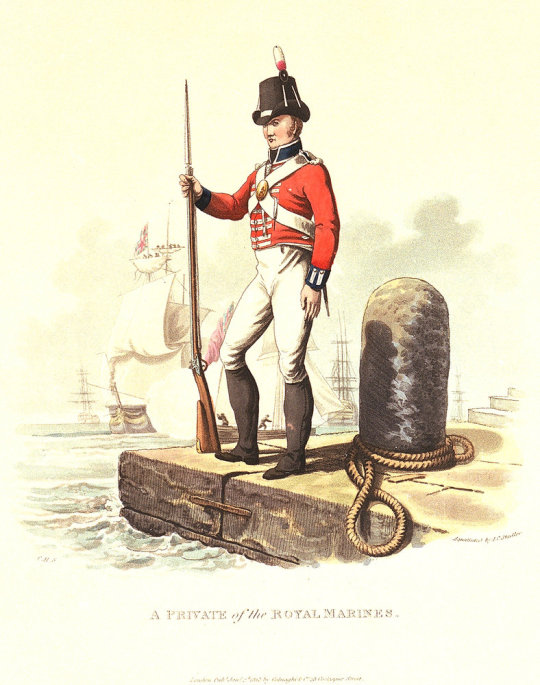
A Private of the Royal Marines 1815 (x)
They were armed with the Sea Service Brown Bess Musket with attachable bayonet, which was slightly shorter than the Army version st around 0,91m long to make it easier to handle in confined spaces and had a slightly wider bore presumably because of deterioration of the barrel in sea air.

British Sea Service Pattern 1778 Flintlock Musket (x)
If not on guard duty, the marines provided general manpower, giving assistance to the seamen where unskilled heavy labour wa required - hauling capstan when weighing anchor, or carrying heavy loads on board the ship. According to orders, no marine could be offically compelled to work aloft, however some did oblige as volunteers. Some of these, it appears, later became prefessional seamen at their own will.
Life aboard
During the battle the marines provided extra manpower to operate the guns, with most consigned to act as a powdermen who would have been ready to leave their posts to repel boarders. On deck, they formed a disciplined defence at close quarters, providing the necesssary small arms fire with their muskets and leading the boarding parties onto other ships. They were also used to form an amphibious assault force for staging attacks on coastal installations and cutting-out enemy ships at anchor. Parties of marines were often sent ashore to protect captured storerooms, powder magazines or even prisoners.

Marines messed alone (x)
In most ships the marines lived and messed separately from the seamen. This preference was a largely unwritten rule for seamen and the marines alike. The marines’ quarters on ship depended on the ship type or class. In a three -decked first- or second- rate ship- of-the-line they lived on the middle gun deck, on a third or fourth rate ship at the after end of the lower gun deck, and in the single decked frigates they lived at the after end of the berthing deck. Each of these locations was in close proximity to the wardroom of the respective ship type. This was of fundamental importance, as the event of a possible insurrection - a safeguard that proved essential after the mutinies of 1797. By the way, higher ranks from lieutenant upwards had their own cabin in the wardroom.
Payment
Marines were paid by two different systems, with a lower rate when they were afloat than when ashore. In 1797, they pay of a private was raised to 1s per day, or £1.8.0 per lunar month, in parity with the army. This was because some marines had also joined the great Nore and Spithead mutinies to demand better pay and supplies at sea, as did the Seamen. But when they are afloat, this was reduced to 19s 3d per month. The reason for that, while ashore the marine was charged for the cost of his victualling and accommodation. At sea, he also had deductions, in the form of contributions to the Chatham Chest, the surgeon and chaplain; but his food was supplied free charge. The marine afloat also had to pay for his bedding (but not for his hammock), and also for the “slops” which he used for working clothes when not on guard duty.
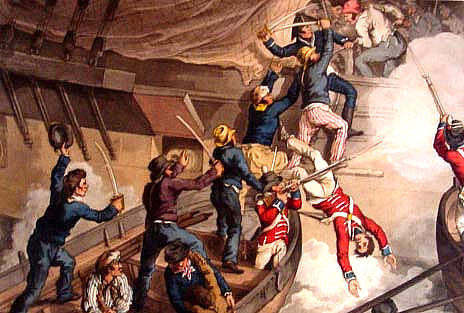
British Sailors Boarding a Man O’ War, 1820 (x)
With an particular rank, pay often increased with length of service. A private with more then seven years service was paid 2s 4d extra when on shore, and 1s 9d when afloat. After 14 years, these allowances were doubled. A sergeant had £ 2.11.4 ashore and £ 2.0.3 afloat. Artillerymen were paid more; a gunner had a minimum of £ 1.15.7 ashore, and a sergeant had £3.18.2.
Miscellaneous
As in the Army, a proportion of Marines were allowed to take their wives with them and this led ot a number of women being present at the major naval battles, wher they were usually assigned to help the surgeon. In 1804 boys of 15 were allowed to join the Marines and height restrictions were lowered to 1,57, but it is believed that most boys were retained in barracks training until they became of age. A number of foreigners and prisoners of war wre also enlisted and although this was stopped in 1810, a number of these Marines went on to have long careers.
Particularly in the early years of the war, when the number of Marines was often inadequate for the Navy’s needs, Army battalions were drafted on board to do the role. At the Battle of Copenhagen in 1801 for example, the 49th Regiment of Foot were on board Nelson’s ships, a role the regiment still proudly commemorates.
#naval history#the marines#18th -19th century#an overview#if you want more let me know#age of sail#the uniforms will come in an extra post
204 notes
·
View notes
Text
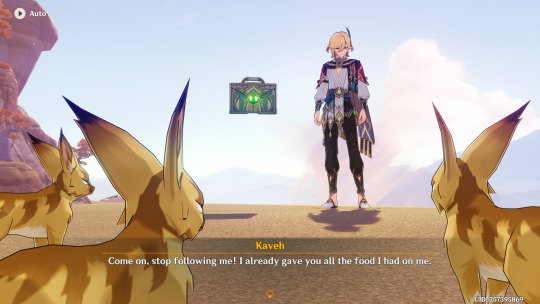

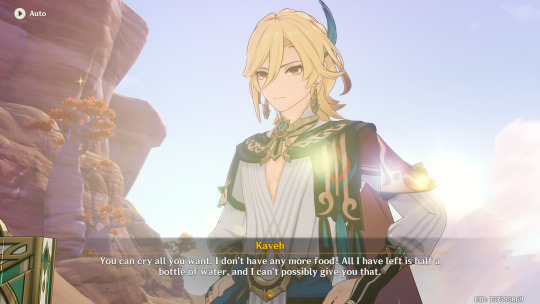



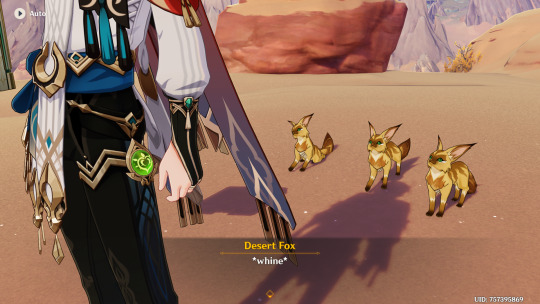



"(...)but I can't just leave them here, can I?"
#He really wants to win#but he can't ignore those he wants to help...#genshin impact#a parade of providence#a parade of providence: act II#kaveh#desert fox#mine.#paimon youre gonna make me cry for him#sweet sweet boy!!!#the purest boy!#i lvoe him so much#andi now understand all the disney princess references#kaveh i'll build u a palace for you and your foxes my beloved
26 notes
·
View notes
Text
V as a NPC
Huge thanks to @visceralcoma who came up with this and posted the template here.
The Basics
Name: Vera Hendrix
Age: 26-27
Gender: Female
Sexuality: Bisexual
Nationality/Race: African American
Family: The Bakkers ( absorbed into Snake Nation ), Mother ( killed by Wraiths ), Father ( killed by Wraiths )
Lifepath: Nomad
Style: Kitsch. She wears a mixture of purple and black and dyed her hair a noticeable dark purple. Violet lenses hide her brown eyes, and she wears an old left-arm prosthetic that is skeletal in appearance.
Character Arc
Where can they be found in Night City?: Vera is available in Act II. Look for her just inside the Afterlife waiting for Panam to finish her conversation with Rogue. Talk to her and ask her questions about life as a nomad, to which she’ll give curt and short answers. Extend the conversation long enough, and a drunk patron will harass her. Choosing to talk the drunk down is the only way to trigger the cutscene when she knocks the man unconscious with a punch.
She will then thank you for giving her time to catch him off guard before leaving with Panam. She can also be found helping Panam fix her car in Rancho Coronado, the two of them bickering over each other’s mechanic skills.
Are they introduced via a gig? Or are they connected to the main story somehow?: Heavily associated with the main story as she’s a nomad who moved to Night City to investigate the deaths of her parents.
Before Jackie met V, the two of them did a job together and became close friends, but ultimately drifted apart. Vera attends his funeral, and V can briefly see her in the back of the Coyote before slipping out through the back door in tears. Should you choose to have V follow her, she’ll roughly tell them to fuck off and get in her car, leaving V in the dust. She’ll remember V in Act II in the Afterlife but will keep her responses short and cold...only warming up to V a little if they choose to defend her from the drunk harassing her. Vera becomes an integral part of V’s story. At first, she merely helps them with the Relic to avenge Jackie’s death but soon grows to genuinely care for V and checks her remaining nomad contacts in search of a cure.
What exclusive information about Night City would they be able to offer to the protag?: Exclusive katanas and throwing knives. If V is interested, she’ll teach them how to properly craft a throwing knife and the mods they’ll need for a katana. If V successfully swiped Satori, she’ll become excited and create a unique mod specifically for that sword.
Where is their home in Night City?: Lives in a small, clean apartment in City Center.
What is their character arc?: Desperate to lay Jackie’s spirit to rest and avenge him, Vera approaches V after Panam deals with Nash and confesses that she knows about their friendship with Jackie and the Heist. She will then promptly demand to hear V’s side of the story and, after a moment of silence, decide that she wants in on V’s quest to remove the Relic so long as they do not aid Arasaka. The way Vera sees it, Jackie died because of that damn Relic, and she doesn’t want any more blood spilled over it. She loathes the Silverhand engram and fears Johnny will get V killed to relive his rocker boy glory days.
What side jobs do they have the protag help them with?: Vera will give V a small task in gathering information on a corporate agent, Simon Bradley, responsible for providing Wraiths the location of her parents and paying them eddies to ambush and kill them.
The side job will turn into a series of more side jobs where V slowly puts together the pieces of the murder, ultimately finding out that Vera’s mother used to be a corporate teacher and an integral part of Michiko Arasaka’s faction... At least she was until she met Vera’s father, and they ran off to join the Bakkers.
Simon Bradley was an overeager and determined to cripple the Hato faction by eliminating its key members, Vera’s mother included. It didn’t matter that Violet Hendrix left behind the corporate world to become a Bakker… She was still considered an existing threat. V can either encourage Vera’s roaring rampage of revenge or convince her that Simon’s not worth it.
If there is a romance, what is that romance like and what triggers it and does it culminate to any physical displays of affection - and if so what kind?: If you encourage Vera to go through with her plan to kill Simon, romance will be triggered, and she’ll start to text and call V more often.
V can also pursue her with flirty responses that will make her flustered. However, the flirty banter will eventually trigger a sweet sex scene. After the Parade, Vera, realizing that V kidnapped Hanako Arasaka, will frantically text V and then track them down to the Sunset Motel after they interrogate Hellman.
She is angry and accuses V of not thinking things through like Jackie, sparking a massive argument between them that ends with a timed choice to either pull her in for a kiss, apologize or rebuke her. If you choose the kiss option, there will be a cutscene of the two of you kissing and stumbling to her car where you will eventually have sex with her in the backseat.
For Female!V, she’s top, but for Male!V, she’s a bottom.
Afterward, V and Vera will snuggle in each other’s arms, relishing in the quiet peace until V seizes up again from the Relic’s effects, and Vera quickly drives them to her place to recover. V wakes up to her cooking them breakfast, and they have a long conversation about the Relic and the shortlist of Vera’s contacts who may or may not have a cure for V’s condition. Vera will then ask V if they feel what she feels for them and if you choose Yes, she’ll smile and sit on V’s lap, holding them tight and promising that they’ll get through this together. If you select No, Vera will close her eyes and nod sadly, but otherwise, respect V’s decision.
What is their phone avatar of on the protag’s phone?: A picture of a black coyote with glowing violet eyes and a snarling mouth.
What sort of phone conversations can they have?: If you’re not in a romantic relationship with her and have remained friendly, she will text you updates about her contacts and possible cures, as well as hint that she’s snagged a meeting with Michiko Arasaka. If you’ve romanced her, she’ll constantly text you hilarious memes and talk about future plans to go out on the road together as nomads or stay in the city.
And (put this under a read more for spoilers) how do they connect with the protags ending:
If romanced, she will remain loyal to V in all endings except for Devil and Temperance. If V chooses to stay in the city, Vera will remain with them and not leave during V’s Crystal Palace gig. For the Star ending, Vera is ecstatic that V is joining her on the road, and they’ll sit on the basilisk together to watch the stars.
Add any further detail you want as well!
If you follow Vera’s quests without making a single mistake, she’ll manage to get an audience with Michiko Arasaka, granting the player another choice that does not involve joining up with Hanako. It’s the path with minor bloodshed as Michiko has no desire to kill her relatives but to cripple them and install herself as leader of the Arasaka empire. Vera is unsure about teaming up with an Arasaka, but she is determined to finish what her mother started and introduce Night City to reforms that will help the people. But if you still manage to complete Vera’s quests flawlessly and choose The Nomads she will be right there to aid V.
If you damage your relationship with Vera, she will not contact you any further and leave Night City forever to pursue a new life elsewhere.
#ch: vera hendrix#long post#omg this was so much fun#I seriously need to come up with a bigger backstory for her as an npc
4 notes
·
View notes
Photo
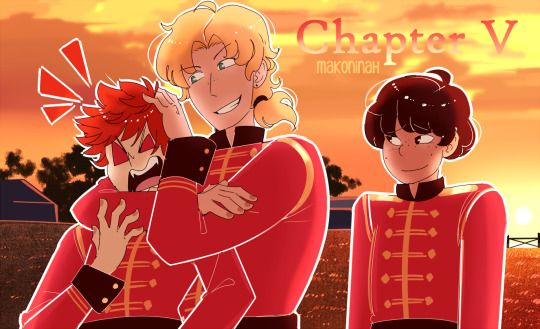
♡ Chapter 5 of TRANSIENT TIME TRAVELLER is out! ♡
○ Read on my Website ○ Read on Tumblr (below) ○ Read on Ao3 ○ Read on Royal Road ○
TTT is an LGBTQ+ historical fantasy novel about Aida, a time traveller hellbent on proving the innocence of a 1,200-year-old dead queen, and Lorian, an escaped princess-turned-officer who wants to drain the royal blood from their body, & the two coming together with the help of their mischievous future selves.
♡ Reblogs are appreciated! ♡
Read Chapter 5 Below:
As Lorian walked into an empty classroom and waited for Aida and Mister Omar to leave, she pressed her back into the door and utterly lost it.
She covered her mouth with her gloved hands. She’d done it. She’d finally talked to Aida again. And she hadn’t been so crass as she’d been when they’d first met. The first time had been a complete disaster. With Aida being naked and Lorian open-mouthed staring at her, the curves of her wide hips and ass, her breasts, her face, her eyes. God help her, she’d never seen a woman’s body so openly before. All she’d wanted to do that night was slam her down into bed and do unspeakable things to her, yet what had Aida wanted? To talk about fantasy novels and a queen who’d been dead for 1,200 years. What had Lorian even said that’d led her up to Aida’s bedroom? She’d need to write it down for reference.
Despite being betrothed for more than half of her life, Lorian hadn’t a clue how courting worked. The girls she’d met in the palace were diplomatic and groomed to please her, all peachy smiles and saying whatever they needed to make her happy. She’d tried to court an Aldaían knight a few years back, but she’d only earned her name and her preference of cakes before they’d parted ways.
Aida’s attitude was so defiant, so cheeky and unbecoming that it would’ve sent Lorian’s father into hysterics. She wanted her. She wanted to crack her open and explore her mind and passions and give it back to her a ten-thousand fold.
Lorian dragged her hands down her face. Maybe she’d buy her a history book, really push more into the things she loved, or maybe a ticket to En Tempore Rose. The official one, the one that played in the Colosseum. She’d have to schedule a trip to the city center. She’d wear a cloak.
After she heard Aida run off somewhere, Lorian re-entered the library and backtracked for the books Aida had put away. They were old and leather-bound, with yellow pages that smelled of mothballs: History of Roma: From the Perspective of King Julius II to His People and Hidden Dangers of Visatorre in Roman History.
Lorian put that last one back. Aida was brave to read about history that was so rarely taught in class. Lorian had secretly read about it behind Missus’ Sharma’s back. She’d learned about the lost city-state of Siina and the belligerent queen who killed one of the dead kings, and how they killed and tortured those poor Visatorre people for sport soon afterwards as punishment. Thrown into the Colosseum with a pack of lions without any weapons with which to defend themselves. In this aisle alone, Lorian saw four other books detailing what a plight the Visatorre were to other people not blessed with the ability to travel through time.
She believed. The power to go back in time, acting as a ghost to witness history in the raw way it was intended, only to come back and harbor the pains of going backwards. She’d never understand their full pain, she could only educate herself and hope that that injustice would never happen again in her history.
After skimming through more of Aida’s books and realizing how little of it she retained, Lorian picked up the shortest read and went near the windows for light.
She got to page ten, most of which was a glorified chapter about how great the Roman kings were and are, when she heard someone call her name.
“Lorian, you fuck!”
Between the library and the writing hall was a strip of muddy grass. It was a shortcut between the buildings for her and other officers to travel. Two of them were there, calling for her: Alessio and Matteo, the two assholes she’d befriended that month.
“There he is, little bugger,” Alessio said, catching Lorian’s profile from the window. He climbed onto a rock wall to get closer. “Get out of there and come down. Lunch’s almost over!”
“Alright, alright,” she said, and slotted the book for later.
They were good boys, these two. She liked them enough to hang out with them while not on duty. They didn’t know this, and they never would, but she’d actually known them back at the palace. All officers-in-training had to go through a mandatory training program held by a Constable. Lorian had always favored officers for their rowdiness. She’d watch them work out in secret, sneak peeks at their naked bodies when they’d change. When she’d found that both Alessio and Matteo were working as security details at this academy, her decision had been made. A few faked letters of recommendation and her crafty ability to lie through her teeth and she was enrolled as an officer-in-training in a week.
They’d never known it was her as she paraded around as a young, unfavorable princess with incredibly long hair wearing the dresses she loathed, but she liked to tease them every now again with knowledge she shouldn’t have known.
“Hey, Alessio, have you ever been persuaded to eat worms?”
“Matteo, didn’t you pee yourself after seeing a real lion in captivity?”
“Have you two ever kissed on a dare?”
She’d lied to them, calling herself a good guesser.
She walked out of the library and turned the corner to find her boys, but they weren’t there. The yard was quiet; she heard the teachers writing on the chalkboard from the writing rooms.
She stilled her steps. From her knowledge, she knew nobody could truly vanish from the world for good. Something would always bring you back to where you were meant to be.
A twig snapped behind her, and she was put into a chokehold that stole away her breath. She could’ve gotten out of it easily, but she didn’t want to hurt who, from their laughing, she knew was Alessio. Alessio was a redhead with more power than Lorian believed him to have. Matteo, on the other hand, was softer, with dark, floppy hair and innocent eyes.
Laughing, Lorian took out her rapier and used the butt of the sword to knock the wind out of Alessio.
Alessio gagged and let her go. “Ow! You ass.”
“You attacked me.” She lightly kicked him for good measure. “What’re we doing now?”
“Late lunch,” Matteo said, and shared a loaf of bread. They weren’t students, but through their enlistment, they were given a dorm room that she shared with Alessio and Matteo and three simple meals ordained by their royal regimen. Sometimes, if they wooed the right girl or boy, they’d get sweets and even alcohol, something that was forbidden to officers. All three of them had already gotten drunk in that month alone.
They walked to their preferred eating space that the Academy cheekily called “The Defense Wall.” It separated the school from the villainous farmlands of lazy cows and stupid chickens. What used to be a formidable, three-meter tall fortress from a time period Aida probably knew about was now a blockage from the smelly farm animals that provided the school a portion of their eggs, milk, cheese, and occasional meat.
Lorian hopped atop an abandoned wagon of hay to scale the tall wall. Alessio followed her, and they needed to help Matteo make it due to his size. There, they shared their bread and butter and made horrible jokes for hours that, if any other officer heard them say, they would’ve had their hands whipped. Lorian had had her fair share of that back home and was keen not to get struck again for misbehaving.
As Lorian dined, Alessio asked her, “Why do you always spend your time in those libraries? You never read.”
It was true, Lorian wasn’t so much a learned soul as her mother and father pretended she was. She was a physical person who liked getting her hands dirty in order to understand something abstract. This had been her fourth trip to the library that week. The first attempt to find and talk to Aida had failed miserably and she was left hiding behind a bookshelf to spy on her. The other try and Aida hadn’t even been there. The girl kept Lorian on a leash and Lorian had no problem with that. “I do read. I know a great deal of things, much more than you do.”
“Then name two books you’ve loved over the past year. No, five authors, and no poets.”
“You try that. When’s the last time you ever picked up a book?” Lorian reached to pull on Alessio’s hair, but he jerked away and stuffed his mouth with his dry loaf end.
“That Miss spends her time there, doesn’t she?” Matteo asked. “That Aida girl.”
“The traveller?” Alessio asked. “She’s a weird one. I’ve talked with some of the girls in her class, and they say she’s really weird. I heard she’s gonna get the nix, you know?” He made a mark across his neck. “Cut out.”
“What do you mean?” Lorian asked.
“I heard it from my father, and he heard it from Constable Carmine. Word from the Lion is that he’s gonna bar those types of people from secondary education.”
Lorian’s ears heated up. “Carmine said that? And the king agreed to it? When?”
Alessio slowed his chewing at Lorian’s mention of Carmine’s name without his title. She had to stop doing that, being so informal about a man she shouldn’t have known so personally. “That’s just what I heard from my dad, so I think it’s true.”
Lorian rubbed her neck. She knew Carmine well enough to forgo titles when she’d address him in the palace, but after being promoted to Constable, she couldn’t say if this was something he’d enforce under the king’s orders or not. He’d exchange his heart for his duty.
But she wouldn’t have put this horrendous action past her father. He was the most racist, hurtful, selfish person she’d ever known, and she hated herself that parts of his speech and behaviors had sunk into her own bones. It took a great deal of unlearning to undo all of those negative stereotypes, and it took her finally leaving the house and joining the ranks to realize how real Visatorre people lived and how awful the world was to them.
“What’s to happen to her?” Matteo asked when they went silent.
“Dunno,” Alessio said. “Kick her out? There’s only a few of those people here, so it’s not like we’d notice right away.”
“But that’s not fair,” Lorian said. “She hasn’t done anything.”
“That’s not gonna stop them, you know that.”
“Then…I’ll stop them,” she promised, and tried mimicking how confident Aida sounded whenever she opened her mouth. “It’s not right. Do you know Miss Mirko uses a cane because of her illness—” She bit her cheek. “Uh, affliction. Can you imagine walking around with a cane at our age? It’s uncouth to belittle those who were born with advantages we weren’t given.”
Alessio pulled a face. “Don’t act high and mighty to me. This wasn’t my decision, I’m just the fucking messenger. And it’s not like we can change this.”
“Say I become a leading Constable, then,” Lorian argued. “I’d rewrite the rules to make them fair for everyone.”
“You wanna be a Constable?”
“Don’t you? Isn’t that the goal of being an officer, to one day be a Constable?”
“Eh, not really. Not for me, anyway. I just needed to get away from my mother, and this was the best option. To be a Constable means you have to put in ten, sometimes fifteen-hour-days and be on the king’s every beck and call. Thanks, but I’m good just being ordered around for simple things.”
“And I wanted to become stronger like my brothers are, but I don’t think I’m strong enough to do everything a Constable does,” Matteo said, and he looked across the field towards the water well. “Oh.”
Alessio and Lorian followed his intent gaze.
“Speak of the devil,” Alessio said.
Stomping down the fields, dress lifted to keep from stepping in cow droppings, was Aida on a mission. Her hands were bunched up in her dress, her teeth grit, and she was mumbling something to herself as her heels plowed through the dry mud. She’d lost her cane, shortening her steps.
Lorian brushed the crumbs off of her chest and stood up higher to better see her. She always walked with such determination, like she truly did not care how other people saw her. Lorian wanted to walk like that one day.
“Do you need a hand, Miss?” Alessio called out.
“Fuck off!” Aida yelled back.
Alessio tensed up. “What the fuck’s her problem?” he muttered.
“S-she isn’t allowed to talk to us like that,” Matteo said meekly. “What should we do?”
“We need to stop her. Hey—”
Lorian palmed Alessio’s chest, almost knocking him off completely before clutching his jacket and keeping him vertical.
“Ow! Lorian, what’s with you today?”
Lorian stared intently at Aida.
Silent tears were running down Aida’s cheeks as she walked. She wasn’t sobbing or weeping, the tears were simply there, though it was hard to tell why she was crying in the first place. It looked like she was off to kill somebody.
When she was out of sight and then some, Lorian got up, told her friends that she was thirsty, and secretly tailed Aida down her chosen path.
#Transient Time Traveller#art#original character#lgbtq#cottagecore#queer#aida#lorian#alessio#matteo#fantasy#original#original art#oc#novel#writing#ttt#royal road#ao3#archive of our own#Alessio: >:OOO
17 notes
·
View notes
Text
HOLLYWOOD BOND CAVALCADE
September 4, 1943

On September 4, 1943, the Hollywood Bond Cavalcade departed to raise money for America’s Third War Loan. It began in Washington DC and went through 16 American cities before ending in San Francisco 21 days later. Millions of Americans flocked to these events buying war bonds as their tickets, with seat prices ranging from $18.75 to $1 million. After crossing 10,091 miles, the campaign raised a total of $40,110,000 and pushed America’s War Loan over the $2 billion mark.
The Hollywood Victory Committee was an organization founded on December 10, 1941 during World War II to provide a means for stage, screen, television and radio performers that were not in military service to contribute to the war effort through bond drives and improving morale for troops. It was associated with the Screen Actors Guild. The Committee organized events between January 1942 until August 1945. Its first chairman was Clark Gable.

This was not the first such event. In 1942, Desi Arnaz participated in the Hollywood Victory Caravan. He was joined by stars Joan Bennett, Joan Blondell, Charles Boyer, James Cagney, Claudette Colbert, Jerry Colonna, Bing Crosby, Olivia de Havilland, Cary Grant, Charlotte Greenwood, Bob Hope, Frances Langford, Laurel and Hardy, Bert Lahr, Groucho Marx, Frank McHugh, Ray Middleton, Merle Oberon, Pat O'Brien, Eleanor Powell, and Risë Stevens. The Caravan show played in 12 cities and netted over $700,000 for Army and Navy relief funds. [Note that in the above Minneapolis welcome sign, Desi’s surname is mis-spelled!]
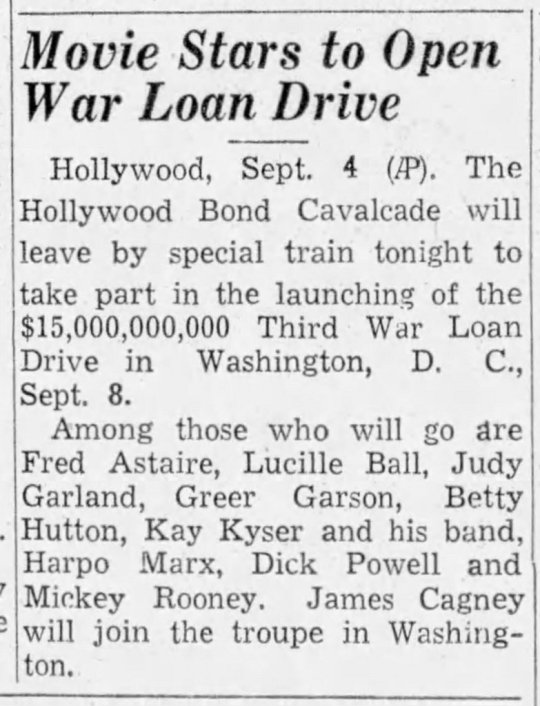
Along with Lucille Ball, some of the celebrities involved included:
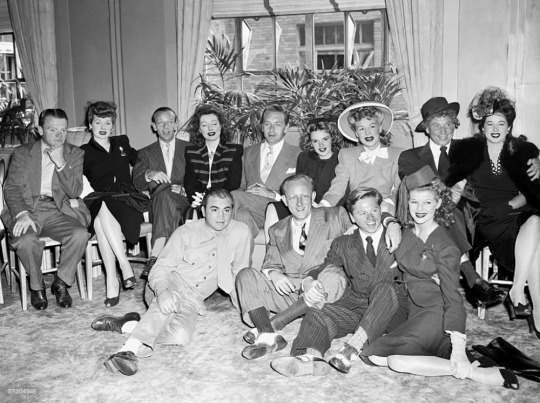
James Cagney ~ had just opened his film Johnny Come Lately on September 3, 1943.
Judy Garland ~ won a 1940 special Oscar for her contributions to film. In September 1943, she released Thousands Cheer (co-starring Lucille Ball) and two months later, Girl Crazy with Mickey Rooney.
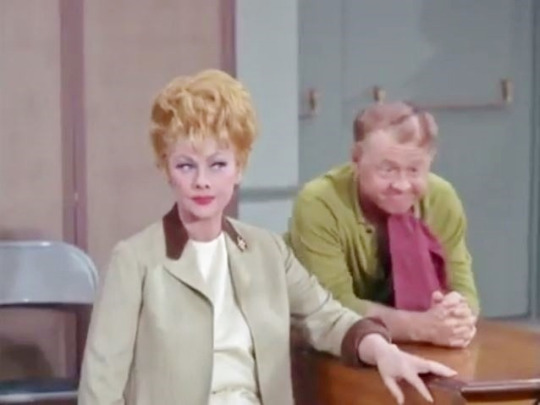
Mickey Rooney ~ was also in Thousands Cheer with Garland and Ball, as well as premiering Girl Crazy with Judy Garland in November 1943. Rooney won Oscars in 1939 and 1940. In 1966 he played himself on an episode of “The Lucy Show.”
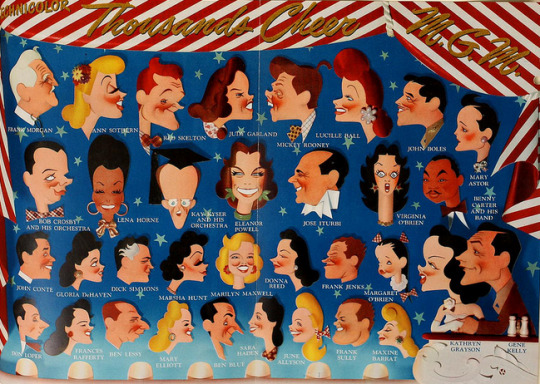
Kay Kyser ~ was a bandleader who made his film debut with Lucille Ball in That’s Right - You’re Wrong. He made four films in 1943, including Thousands Cheer.
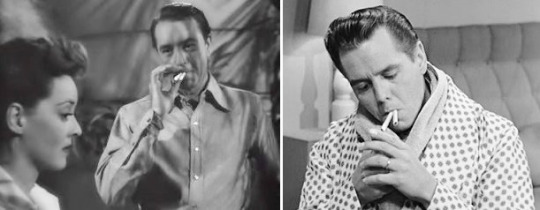
Paul Henreid ~ was most known for playing Victor Laszlo in Casablanca (1942). His name was mentioned on “I Love Lucy” in “The Adagio” (ILL S1;E12) when Ricky lights two cigarettes at once, just a Paul Henreid did for Bette Davis in 1942′s Now Voyager.
Greer Garson ~ won Oscars in 1940, 1942, and 1943, for Mrs. Miniver, her most recent success at the time. She had a film in release called The Youngest Profession and was about to debut another hit, Madame Curie.
Betty Hutton ~ was an actress and singer who was seen that summer of ‘43 in Let’s Face It, starring Bob Hope.
Kathryn Grayson ~ was yet another Cavalcade member starring in Thousands Cheer.

Harpo Marx ~ is best known for the act he developed with his brothers that was a hit on Broadway and screen. He was a silent clown in an over-sized raincoat and fright wig. Lucy and Harpo had appeared together in Room Service in 1938. In 1955, he guest-starred on “I Love Lucy” (S4;E28) as himself.
Fred Astaire ~ was one of Hollywood’s most legendary dancers. In July 1943 he released The Sky’s The Limit with Joan Leslie. In 1943, he had already done three musical films with Lucille Ball, and was about to film a fourth - Ziegfeld Follies. His name was mentioned on two episodes of “I Love Lucy.”
Olivia DeHavilland ~ was a two-time Oscar nominee at the time of the Cavalcade. She memorably played Melanie Wilkes in Gone With The Wind in 1939.
Martha Scott ~ was a 1940 Oscar nominee for the screen version of Our Town. Her film Hi Diddle Diddle was in release during the summer of 1943.
Dick Powell ~ was preparing to premiere Riding High with Dorothy Lamour in November 1943. He was about to start filming Meet the People with Lucille Ball, which opened in 1944.
The stars participated upon behest of the US Treasury Department.

A special 11-car Union Pacific Railroad train carried the stars from Los Angeles, to Washington DC for the kick-off.

Union Pacific Railroad provided access to their new Domeliner for location and second unit footage on “I Love Lucy” during “The Great Train Robbery” (S5;E5).
Tour Schedule:
Sept 4 - Depart Los Angeles
Sept 8 – Washington, DC
Sept 9 – Philadelphia
Sept 10 – Boston
Sept 11 – New York
Sept 12 – Pittsburgh
Sept 13 – Cleveland
Sept 14 – Detroit
Sept 15 – Cincinnati
Sept 16 – Chicago
Sept 17 – Minneapolis
Sept 18 – St Louis
Sept 20 – New Orleans
Sept 21 – Dallas
Sept 22 – San Antonio
Sept 25 – San Francisco
Sept 26 & 27 – Los Angeles
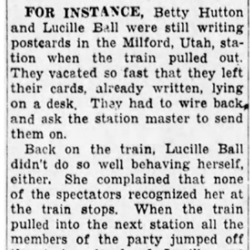
A Typical Cavalcade Performance (depending on celebrity availability)
Kay Kyser served as master of ceremonies and started the show with his band's theme "Thinking Of You". James Cagney came on to read a poem - "What Do We Do When We Buy A Bond" - and did two numbers and a dance from Yankee Doodle Dandy, for which he had recently won the Academy Award. Dick Powell then crooned some of his hits: "Don't Give Up The Ship," "Let's Get Lost," "In My Arms," and "Happy Go Lucky".
Harpo Marx would intermittently chase a blonde across the stage. He eventually settled down to play two harp solos, bang on the piano, wheeze on the harmonica, and finally played a pantomime poker game with Lucille Ball, who had appeared with Harpo in Room Service in 1938 and learned physical comedy at his knee. Harpo ended the game by cutting the cards with an ax!
After Fred Astaire danced, Kyser brought down the house with a burlesque imitation of his style. Mickey Rooney did imitations of Franklin Roosevelt, Eleanor Roosevelt, Herbert Hoover, Wendell Wilkie, and then played the drums.
Betty Hutton performed some hot boogie-woogie. Judy Garland sang "The Man I Love," "Embraceable You," and "Blow, Gabriel, Blow."
Greer Garson urged continued bond purchases, saying, "If we relax, if we don't back the attack, the war will go on indefinitely."

Upon arrival in Washington DC on September 8, Lucille Ball and the stars paraded through the streets in military jeeps, waving to the assembled crowds on their way to the Washington Monument. A similar parade was held in most all subsequent cities.

After departing DC, the stars embarked on a 15 city ‘barn-storming’ tour of American cities.
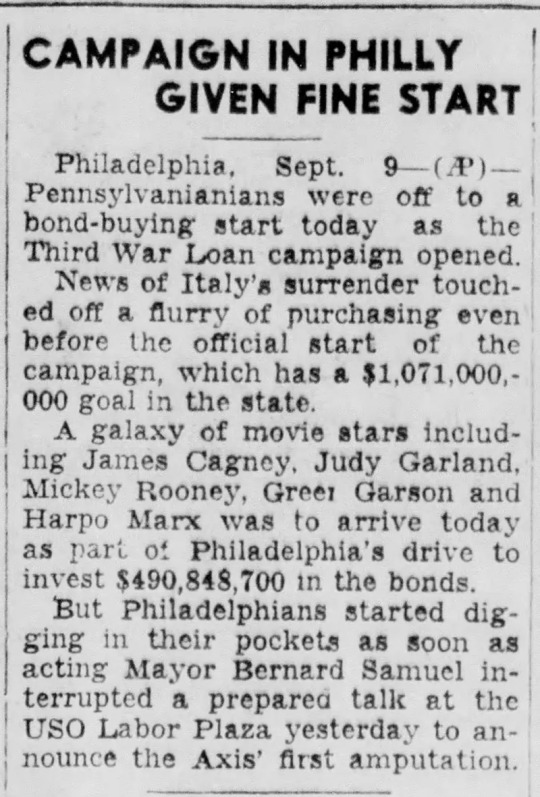
September 9 ~ the Cavalcade played Philadelphia's Convention Hall...

...and moved to play Boston on September 10.
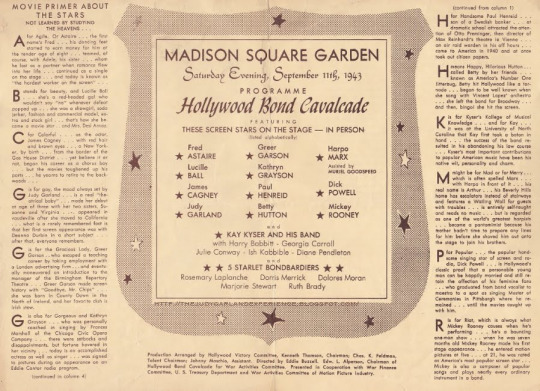
September 11 ~ at Madison Square Garden in New York City. It was here that Betty Hutton announced her engagement to camera manufacturer Ted Briskin. They tied the knot in 1945 but the marriage ended in divorce in 1951.
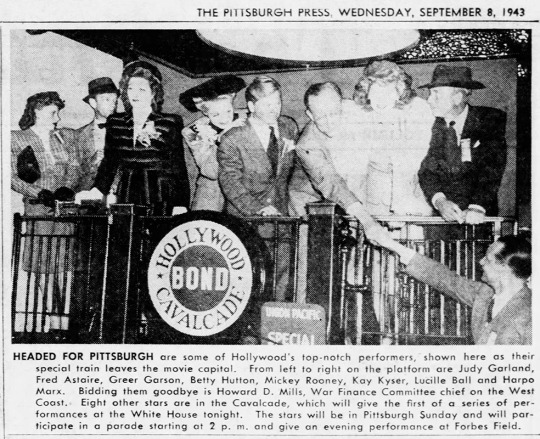
September 12 ~ Pittsburgh, Pennsylvania. The newspapers promoted its arrival with this photo from their Los Angeles departure.

September 13 ~ the Cavalcade rolled through Cleveland, Ohio the stars spoke to an assembly of Defense Workers. That night, at the Civic Auditorium, Kay Kyser auctioned off an American flag for $10,000,000 and two pounds of butter and a three pound steak for $100,000 each!
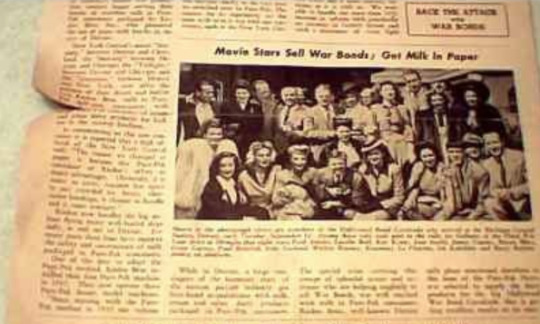
September 14 ~ Detroit, Michigan

September 15 ~ Cincinnati, Ohio. Stars rode into town on chartered Cincinnati Street Railway buses kicked off at Union Station. Lucille Ball is 8th from the right, next to Harpo Marx.
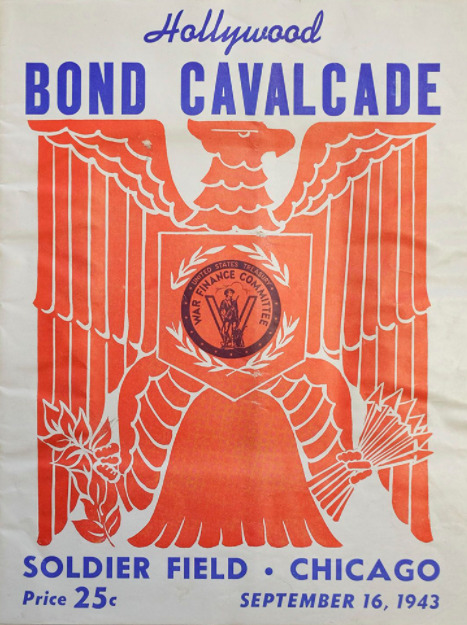
September 16 in Chicago’s Soldier Field.

September 17 in Minneapolis, Minnesota.

September 18 in St. Louis, Missouri at the Kiel Auditorium. Most of the stars lodged at the Hotel Jefferson, where police had to chase 300 autograph hounds out of the lobby. They also had to drag a high school girl out from beneath Fred Astaire's bed. In another incident, surging fans shattered a plate glass window, which tore Judy Garland's dress to shreds.
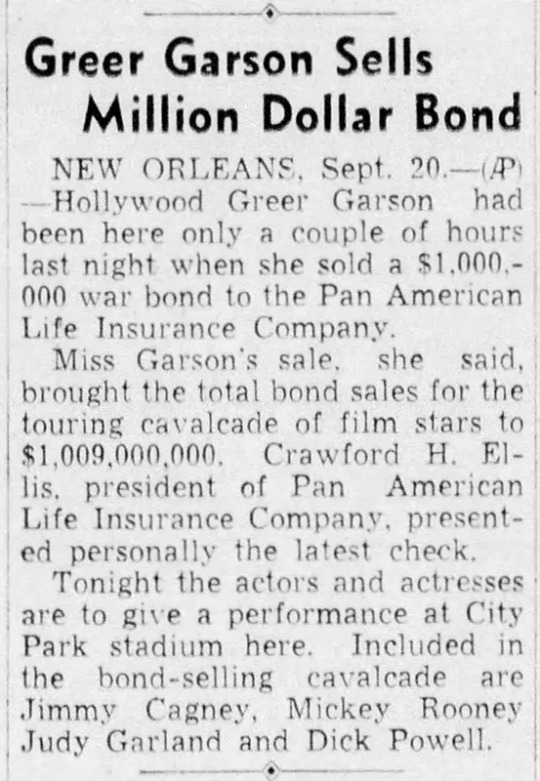
September 19 was left as an ‘open’ day in New Orleans, Louisiana, before their official performances on September 20 at the Tad Gormley Stadium. Variety reported the crowd at 50,000, The States stated it was between 65,000 and 75,000, while The Item claimed 100,000 showed up, despite the actual venue only seating 35,000!

September 21 in Dallas, Texas at the Cotton Bowl...
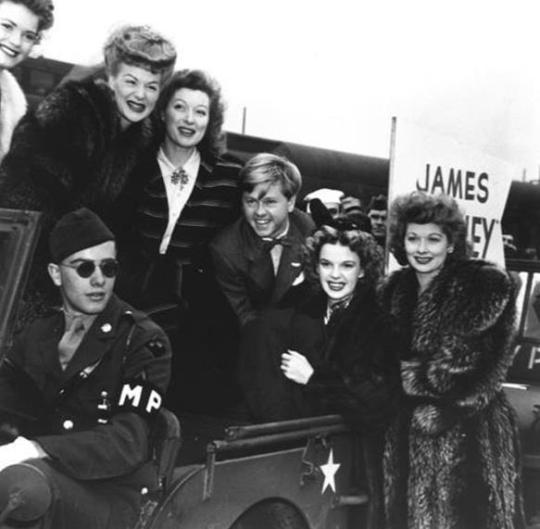
...and in San Antonio, Texas on September 22.

September 25 in San Francisco to perform...

...and on September 26 went home to Los Angeles to conclude the 10,000 mile tour. A crowd of 6,000 greeted them at the station in Glendale as the Navy Band played "California, Here I Come."

The song would memorably be sung on “I Love Lucy” to launch the Hollywood episodes in 1955.
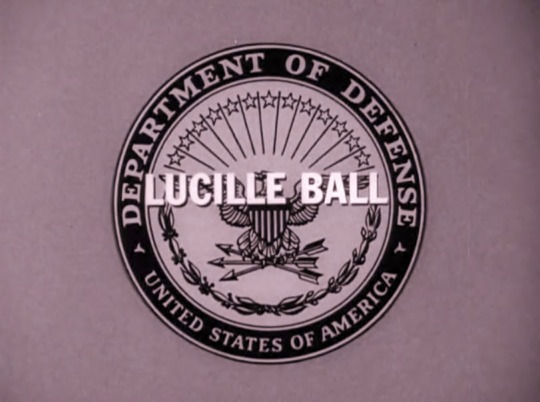
Lucille Ball helped sell bonds throughout her career. Click here for a look at Lucy and US Savings Bonds!
16 notes
·
View notes
Text
Sammy Davis, Jr.

Samuel George Davis Jr. (December 8, 1925 – May 16, 1990) was an American singer, musician, dancer, actor, vaudevillian, comedian, and activist known for his impressions of actors, musicians, and other celebrities. At age three, Davis began his career in vaudeville with his father Sammy Davis Sr. and the Will Mastin Trio, which toured nationally. After military service, he returned to the trio and became an overnight sensation following a nightclub performance at Ciro's (in West Hollywood) after the 1951 Academy Awards. With the trio, he became a recording artist. In 1954, at the age of 29, he lost his left eye in a car accident. Several years later, he converted to Judaism, finding commonalities between the oppression experienced by African-American and Jewish communities.
After a starring role on Broadway in Mr Wonderful (1956), he returned to the stage in 1964's Golden Boy. Davis's film career began as a child in 1933. In 1960, he appeared in the Rat Pack film Ocean's 11. In 1966, he had his own TV variety show, titled The Sammy Davis Jr. Show. While Davis's career slowed in the late 1960s, his biggest hit, "The Candy Man", reached the top of the Billboard Hot 100 in June 1972, and he became a star in Las Vegas, earning him the nickname "Mister Show Business".
Davis had a complex relationship with the black community and drew criticism after publicly supporting President Richard Nixon in 1972. One day on a golf course with Jack Benny, he was asked what his handicap was. "Handicap?" he asked. "Talk about handicap. I'm a one-eyed Negro who's Jewish." This was to become a signature comment, recounted in his autobiography and in many articles.
After reuniting with Frank Sinatra and Dean Martin in 1987, Davis toured with them and Liza Minnelli internationally, before his death in 1990. He died in debt to the Internal Revenue Service, and his estate was the subject of legal battles after the death of his wife. Davis was awarded the Spingarn Medal by the NAACP and was nominated for a Golden Globe Award and an Emmy Award for his television performances. He was a recipient of the Kennedy Center Honors in 1987, and in 2001, he was posthumously awarded the Grammy Lifetime Achievement Award.
Early life
Davis was born on December 8, 1925, in the Harlem section of Manhattan in New York City, the son of African-American entertainer and stage performer Sammy Davis Sr. (1900–1988) and Cuban American tap dancer and stage performer Elvera Sanchez (1905–2000). In the 2003 biography In Black and White, author Wil Haygood wrote that Davis's mother was born in New York City to Afro-Cuban parents. Davis's parents were vaudeville dancers. As an infant, he was reared by his paternal grandmother. When he was three years old, his parents separated. His father, not wanting to lose custody of his son, took him on tour.
Davis learned to dance from his father and his "uncle" Will Mastin. Davis joined the act as a child and they became the Will Mastin Trio. Throughout his career, Davis included the Will Mastin Trio in his billing. Mastin and his father shielded him from racism, such as by explaining race-based snubs as jealousy. However, when Davis served in the United States Army during World War II, he was confronted by strong prejudice. He later said: "Overnight the world looked different. It wasn't one color any more. I could see the protection I'd gotten all my life from my father and Will. I appreciated their loving hope that I'd never need to know about prejudice and hate, but they were wrong. It was as if I'd walked through a swinging door for 18 years, a door which they had always secretly held open." At age seven, Davis played the title role in the film Rufus Jones for President, in which he sang and danced with Ethel Waters. He lived for several years in Boston's South End, and reminisced years later about "hoofing and singing" at Izzy Ort's Bar & Grille.
Military service
During World War II, Davis was drafted into the U.S. Army in 1943 aged 18. He was frequently abused by white soldiers from the South and later recounted that "I must have had a knockdown, drag-out fight every two days." His nose was broken numerous times and permanently flattened. At one point he was offered a beer laced with urine.
He was reassigned to the Army's Special Services branch, which put on performances for troops. At one show he found himself performing in front of soldiers who had previously racially abused him. Davis, who earned the American Campaign Medal and World War II Victory Medal, was discharged in 1945 with the rank of private. He later said, "My talent was the weapon, the power, the way for me to fight. It was the one way I might hope to affect a man's thinking."
Career
After his discharge, Davis rejoined the family dance act, which played at clubs around Portland, Oregon. He also recorded blues songs for Capitol Records in 1949, under the pseudonyms Shorty Muggins and Charlie Green.
On March 23, 1951, the Will Mastin Trio appeared at Ciro's as the opening act for headliner Janis Paige. They were to perform for only 20 minutes but the reaction from the celebrity-filled crowd was so enthusiastic, especially when Davis launched into his impressions, that they performed for nearly an hour, and Paige insisted the order of the show be flipped. Davis began to achieve success on his own and was singled out for praise by critics, releasing several albums.
In 1953, Davis was offered his own television show on ABC, Three for the Road — with the Will Mastin Trio. The network spent $20,000 filming the pilot which presented African Americans as struggling musicians, not slapstick comedy or the stereotypical mammy roles of the time. The cast included Frances Davis who was the first black ballerina to perform for the Paris Opera, actresses Ruth Attaway and Jane White, and Federick O'Neal who founded the American Negro Theater. The network couldn't get a sponsor, so the show was dropped.
In 1954, Davis was hired to sing the title song for the Universal Pictures film Six Bridges to Cross. In 1956, he starred in the Broadway musical Mr. Wonderful.
In 1958, Davis was hired to crown the winner of the Miss Cavalcade of Jazz beauty contest for the famed fourteenth Cavalcade of Jazz concert produced by Leon Hefflin Sr. held at the Shrine Auditorium on August 3. The other headliners were Little Willie John, Sam Cooke, Ernie Freeman, and Bo Rhambo. The event featured the top four prominent disc jockey of Los Angeles.
In 1959, Davis became a member of the Rat Pack, led by his friend Frank Sinatra, which included fellow performers Dean Martin, Joey Bishop, and Peter Lawford, a brother-in-law of John F. Kennedy. Initially, Sinatra called the gathering "the Clan", but Davis voiced his opposition, saying that it reminded people of the Ku Klux Klan. Sinatra renamed the group "the Summit". One long night of poker that went on into the early morning saw the men drunken and disheveled. As Angie Dickinson approached the group, she said, "You all look like a pack of rats." The nickname caught on, and they were called the Rat Pack, the name of its earlier incarnation led by Humphrey Bogart and Lauren Bacall, who originally made the remark of the "pack of rats" about the group around her husband Bogart.
The group around Sinatra made several movies together, including Ocean's 11 (1960), Sergeants 3 (1962), and Robin and the 7 Hoods (1964), and they performed onstage together in Las Vegas.In 1964, Davis was the first African American to sing at the Copacabana night club in New York.
Davis was a headliner at The Frontier Casino in Las Vegas, but, due to Jim Crow practices in Las Vegas, he was required (as were all black performers in the 1950s) to lodge in a rooming house on the west side of the city, instead of in the hotels as his white colleagues did. No dressing rooms were provided for black performers, and they had to wait outside by the swimming pool between acts. Davis and other black artists could entertain but could not stay at the hotels where they performed, gamble in the casinos, or dine or drink in the hotel restaurants and bars. Davis later refused to work at places which practiced racial segregation.
Canada provided opportunities for performers like Davis unable to break the color barrier in U.S. broadcast television, and in 1959, he starred in his own TV special Sammy's Parade on the Canadian network CBC It was a breakthrough event for the performer, as in the United States in the 1950s, corporate sponsors largely controlled the screen: "Black people [were] not portrayed very well on television, if at all," according to Jason King of the Clive Davis Institute of Recorded Music.
In 1964, Davis was starring in Golden Boy at night and shooting his own New York-based afternoon talk show during the day. When he could get a day off from the theater, he recorded songs in the studio, performed at charity events in Chicago, Miami, or Las Vegas, or appeared on television variety specials in Los Angeles. Davis felt he was cheating his family of his company, but he said he was incapable of standing still.
Although he was still popular in Las Vegas, he saw his musical career decline by the late 1960s. He had a No. 11 hit (No. 1 on the Easy Listening singles chart) with "I've Gotta Be Me" in 1969. He signed with Motown to update his sound and appeal to young people. His deal to have his own label with the company fell through. He had an unexpected No. 1 hit with "The Candy Man" with MGM Records in 1972. He did not particularly care for the song and was chagrined that he had become known for it, but Davis made the most of his opportunity and revitalized his career.
Although he enjoyed no more Top 40 hits, he did enjoy popularity with his 1976 performance of the theme song from the Baretta television series, "Baretta's Theme (Keep Your Eye on the Sparrow)" (1975–1978), which was released as a single (20th Century Records). He appeared on the television shows The Rifleman, I Dream of Jeannie, All in the Family (during which he famously kisses Archie Bunker (Carroll O'Connor) on the cheek), and Charlie's Angels (with his wife, Altovise Davis). He appeared in Japanese commercials for Suntory whisky in the 1970s.
On December 11, 1967, NBC broadcast a musical-variety special featuring Nancy Sinatra, daughter of Frank Sinatra, titled Movin' with Nancy. In addition to the Emmy Award-winning musical performances, the show is notable for Nancy Sinatra and Davis greeting each other with a kiss, one of the first black-white kisses in US television.
Davis had a friendship with Elvis Presley in the late 1960s, as they both were top-draw acts in Vegas at the same time. Davis was in many ways just as reclusive during his hotel gigs as Elvis was, holding parties mainly in his penthouse suite which Elvis occasionally attended. Davis sang a version of Presley's song "In the Ghetto" and made a cameo appearance in Presley's concert film Elvis: That's the Way It Is. One year later, he made a cameo appearance in the James Bond film Diamonds Are Forever, but the scene was cut. In Japan, Davis appeared in television commercials for coffee, and in the United States he joined Sinatra and Martin in a radio commercial for a Chicago car dealership.
On May 27–28, 1973, Davis hosted (with Monty Hall) the first annual, 20-hour Highway Safety Foundation telethon. Guests included Muhammad Ali, Paul Anka, Jack Barry, Dr. Joyce Brothers, Ray Charles, Dick Clark, Roy Clark, Howard Cosell, Ossie Davis, Ruby Dee, Joe Franklin, Cliff Gorman, Richie Havens, Danny Kaye, Jerry Lewis, Hal Linden, Rich Little, Butterfly McQueen, Minnie Pearl, Boots Randolph, Tex Ritter, Phil Rizzuto, The Rockettes, Nipsey Russell, Sally Struthers, Mel Tillis, Ben Vereen, and Lawrence Welk. It was a financial disaster. The total amount of pledges was $1.2 million. Actual pledges received were $525,000.
Davis was a huge fan of daytime television, particularly the soap operas produced by the American Broadcasting Company. He made a cameo appearance on General Hospital and had a recurring role as Chip Warren on One Life to Live, for which he received a 1980 Daytime Emmy Award nomination. He was also a game show fan, appearing on Family Feud in 1979 and Tattletales with his wife Altovise in the 1970s.
After his bout with cirrhosis due to years of drinking, Davis announced his sponsorship of the Sammy Davis Jr. National Liver Institute in Newark, New Jersey in 1985. In 1988, Davis was billed to tour with Frank Sinatra and Dean Martin, but Sinatra and Martin had a falling out. Liza Minnelli replaced Dean on the tour dubbed as ''The Ultimate Event.'' During the tour in 1989, Davis was diagnosed with throat cancer; his treatments prevented him from performing.
Personal life
Accident and conversion
Davis nearly died in an automobile accident on November 19, 1954, in San Bernardino, California, as he was making a return trip from Las Vegas to Los Angeles. During the previous year, he had started a friendship with comedian and host Eddie Cantor, who had given him a mezuzah. Instead of putting it by his door as a traditional blessing, Davis wore it around his neck for good luck. The only time he forgot it was the night of the accident. The accident occurred at a fork in U.S. Route 66 at Cajon Boulevard and Kendall Drive. Davis lost his left eye to the bullet-shaped horn button (a standard feature in 1954 and 1955 Cadillacs) as a result. His friend, actor Jeff Chandler, said he would give one of his own eyes if it would keep Davis from total blindness. Davis wore an eye patch for at least six months following the accident. He was featured with the patch on the cover of his debut album and appeared on What's My Line? wearing the patch. Later, he was fitted for a glass eye, which he wore for the rest of his life.
Eddie Cantor talked to Davis in the hospital about the similarities between the Jewish and black cultures. Davis, who was born to a Catholic mother and Baptist father, began studying the history of Jews. He converted to Judaism several years later in 1961. One passage from his readings (from the book A History of the Jews by Abram L. Sachar), describing the endurance of the Jewish people, interested him in particular: "The Jews would not die. Three millennia of prophetic teaching had given them an unwavering spirit of resignation and had created in them a will to live which no disaster could crush." The accident marked a turning point in Davis's career, taking him from a well-known entertainer to a national celebrity.
Marriages
In 1957, Davis was involved with actress Kim Novak, who was under contract with Columbia Pictures. Because Novak was white, Harry Cohn, the president of Columbia, gave in to his worries that racist backlash against the relationship could hurt the studio. There are several accounts of what happened, but they agree that Davis was threatened by organized crime figures close to Cohn. According to one account, Cohn called racketeer John Roselli, who was told to inform Davis that he must stop seeing Novak. To try to scare Davis, Roselli had him kidnapped for a few hours. Another account relates that the threat was conveyed to Davis's father by mobster Mickey Cohen. Davis was threatened with the loss of his other eye or a broken leg if he did not marry a black woman within two days. Davis sought the protection of Chicago mobster Sam Giancana, who said that he could protect him in Chicago and Las Vegas but not California.
Davis briefly married black dancer Loray White in 1958 to protect himself from mob violence; Davis had previously dated White, who was 23, twice divorced and had a six-year-old child. He paid her a lump sum, $10,000 or $25,000, to engage in a marriage on the condition that it would be dissolved before the end of the year. Davis became inebriated at the wedding and attempted to strangle White en route to their wedding suite. Checking on him later, Silber found Davis with a gun to his head. Davis despairingly said to Silber, "Why won't they let me live my life?" The couple never lived together, and commenced divorce proceedings in September 1958. The divorce was granted in April 1959.
In 1960, there was another racially charged public controversy when Davis married white, Swedish-born actress May Britt in a ceremony officiated by Rabbi William M. Kramer at Temple Israel of Hollywood. While interracial marriage had been legal in California since 1948, anti-miscegenation laws in the United States still stood in 23 states, and a 1958 opinion poll had found that only 4 percent of Americans supported marriage between black and white spouses. Davis received racist hate mail while starring in the Broadway adaptation of Golden Boy during 1964–1966, in which his character is in a relationship with a white woman, paralleling his own interracial relationship. At the time Davis appeared in the musical, although New York had no laws against it, debate about interracial marriage was still ongoing in America as Loving v. Virginia was being fought. It was only in 1967, after the musical had closed, that anti-miscegenation laws in all states were ruled unconstitutional by the Supreme Court of the United States.
Davis's daughter Tracey Davis revealed in a 2014 book that this marriage also resulted in President Kennedy refusing to allow Davis to perform at his Inauguration. The snub was confirmed by director Sam Pollard, who revealed in a 2017 American Masters documentary that Davis's invitation to perform at his inauguration was abruptly canceled on the night of his inaugural party.
Davis and Britt had one daughter, Tracey, and adopted two sons, Mark and Jeff. Davis performed almost continuously and spent little time with his wife. They divorced in 1968, after Davis admitted to having had an affair with singer Lola Falana. After his marriage imploded, Davis turned to alcohol and "found solace in drugs, particularly cocaine and amyl nitrite, and experimented briefly with Satanism and pornography."
In 1968, Davis started dating Altovise Gore, a dancer in Golden Boy. They were married on May 11, 1970, by the Reverend Jesse Jackson. Kathy McKee replaced Gore in Davis's nightclub act. They adopted a son, Manny, in 1989. Davis and Gore remained married until his death in 1990.
Hobbies
Davis was an avid photographer who enjoyed shooting pictures of family and acquaintances. His body of work was detailed in a 2007 book by Burt Boyar titled Photo by Sammy Davis, Jr. "Jerry [Lewis] gave me my first important camera, my first 35 millimeter, during the Ciro's period, early '50s," Boyar quotes Davis. "And he hooked me." Davis used a medium format camera later on to capture images. Boyar reports that Davis had said, "Nobody interrupts a man taking a picture to ask ... 'What's that nigger doin' here?'" His catalog includes rare photos of his father dancing onstage as part of the Will Mastin Trio and intimate snapshots of close friends Jerry Lewis, Dean Martin, Frank Sinatra, James Dean, Nat "King" Cole, and Marilyn Monroe. His political affiliations also were represented, in his images of Robert Kennedy, Jackie Kennedy, and Martin Luther King Jr. His most revealing work comes in photographs of wife May Britt and their three children, Tracey, Jeff and Mark.
Davis was an enthusiastic shooter and gun owner. He participated in fast-draw competitions. Johnny Cash recalled that Davis was said to be capable of drawing and firing a Colt Single Action Army revolver in less than a quarter of a second. Davis was skilled at fast and fancy gunspinning and appeared on television variety shows showing off this skill. He also demonstrated gunspinning to Mark on The Rifleman in "Two Ounces of Tin." He appeared in Western films and as a guest star on several television Westerns.
Political beliefs
Davis was a registered Democrat and supported John F. Kennedy's 1960 election campaign as well as Robert F. Kennedy's 1968 campaign. John F. Kennedy would later refuse to allow Davis to perform at his inauguration on account of his marriage with the white actress May Britt. Nancy Sinatra revealed in her 1986 book Frank Sinatra: My Father how Kennedy had planned to snub Davis as plans for his wedding to Britt were unfolding. He went on to become a close friend of President Richard Nixon and publicly endorsed him at the 1972 Republican National Convention. Davis also made a USO tour to South Vietnam at Nixon's request.
In February 1972, during the later stages of the Vietnam War, Davis went to Vietnam to observe military drug abuse rehabilitation programs and talk to and entertain the troops. He did this as a representative from President Nixon's Special Action Office For Drug Abuse Prevention. He performed shows for up to 15,000 troops; after one two-hour performance he reportedly said "I've never been so tired and felt so good in my life." The U.S. Army made a documentary about Davis's time in Vietnam performing for troops on behalf of Nixon's drug treatment program.
Nixon invited Davis and his wife, Altovise, to sleep in the White House in 1973, the first time African-Americans were invited to do so. The Davises spent the night in the Lincoln Bedroom. Davis later said he regretted supporting Nixon, accusing Nixon of making promises on civil rights that he did not keep. Davis was a long-time donor to the Reverend Jesse Jackson's Operation PUSH organization.
Illness and death
In August 1989, Davis began to develop symptoms—a tickle in his throat and an inability to taste food. Doctors found a cancerous tumor in Davis's throat. He had often smoked four packs of cigarettes a day as an adult. When told that surgery (laryngectomy) offered him the best chance of survival, Davis replied he would rather keep his voice than have a part of his throat removed; he was initially treated with a combination of chemotherapy and radiation. His larynx was later removed when his cancer recurred. He was released from the hospital on March 13, 1990.
Davis died of complications from throat cancer two months later at his home in Beverly Hills, California, on May 16, 1990, aged 64. He was interred in Forest Lawn Memorial Park in Glendale, California. On May 18, 1990, two days after his death, the neon lights of the Las Vegas Strip were darkened for ten minutes as a tribute.
Estate
Davis left a bulk of his estate, estimated at $4 million, to his widow Altovise Davis, but he owed the IRS $5.2 million which due to interest and penalties had increased to over $7 million. His widow Altovise Davis became liable for his debt because she had cosigned his tax returns. She was forced to auction his personal possessions and real estate. Some of his friends in the industry, including Quincy Jones, Joey Bishop, Ed Asner, Jayne Meadows and Steve Allen, participated in a fundraising concert at the Sands Hotel in Las Vegas. Altovise Davis and the IRS reached a settlement in 1997. After she died in 2009, their son Manny was named executor of the estate and majority rights holder of his intellectual property.
Legacy
On June 25, 2019, The New York Times Magazine listed Davis among hundreds of artists whose material was reportedly destroyed in the 2008 Universal fire.
Portrayals
In an episode of Charlie's Angels, Davis had a dual role, playing both himself and as a Sammy Davis Jr. impersonator who is kidnapped by mistake. (In a comic relief scene the impersonator beats up a candy machine which does not give him his candy, a spoof of Davis's song "The Candy Man".)
Comedian Jim Carrey has portrayed Davis on stage, in the 1983 film Copper Mountain, and in a stand-up routine.
On Saturday Night Live, Davis has been portrayed by Garrett Morris, Eddie Murphy, Billy Crystal and Tim Meadows.
Davis was portrayed on the popular sketch comedy show In Living Color by Tommy Davidson, notably a parody of the film Ghost, in which the ghost of Davis enlists the help of Whoopi Goldberg to communicate with his wife.
David Raynr portrayed Davis in the 1992 miniseries Sinatra, a television film about the life of Frank Sinatra.
In the comedy film Wayne's World 2 (1993), Tim Meadows portrays Davis in the dream sequence with Michael A. Nickles as Jim Morrison.
In the sitcom Malcolm & Eddie (1996), Eddie Sherman (played by comedian Eddie Griffin) impersonates Davis in the episode "Sh-Boing-Boing" to help his partner Malcolm McGee (played by Malcolm-Jamal Warner) reconcile his grandparents' relationship.
Davis was portrayed by Don Cheadle in the HBO film The Rat Pack, a 1998 television film about the group of entertainers. Cheadle won a Golden Globe Award for his performance.
He was portrayed by Paul Sharma in the 2003 West End production Rat Pack Confidential.
Davis was portrayed in 2008 by Keith Powell in an episode of 30 Rock titled "Subway Hero."
In September 2009, the musical Sammy: Once in a Lifetime premiered at the Old Globe Theatre in San Diego with book, music, and lyrics by Leslie Bricusse, and additional songs by Bricusse and Anthony Newley. The title role was played by Tony Award nominee Obba Babatundé.
Comedian Billy Crystal has portrayed Davis on "Saturday Night Live," in his stand-up routines, and at the 2012 Oscars.
Actor Phaldut Sharma created the comedy web-series I Gotta Be Me (2015), following a frustrated soap star as he performs as Sammy in a Rat Pack tribute show.
In January 2017, Davis's estate joined a production team led by Lionel Richie, Lorenzo di Bonaventura, and Mike Menchel to make a movie based on Davis's life and show-biz career.
Honors and awards
Shortly before his death in 1990, ABC aired the TV special Sammy Davis, Jr. 60th Anniversary Celebration. An all-star cast, including Michael Jackson, Eddie Murphy, Diahann Carroll, Clint Eastwood, and Ella Fitzgerald, paid tribute to Davis. The show was nominated for six Primetime Emmy Awards, winning Outstanding Variety, Music or Comedy.
Grammy AwardsEmmy AwardsOther honors
Discography
Filmography
Stage
Mr. Wonderful (1957), musical
Golden Boy (1964), musical – Tony Nomination for Best Actor in a Musical
Sammy (1974), special performance featuring Davis with the Nicholas Brothers
Stop the World – I Want to Get Off (1978) musical revival
Television
General Electric Theater – "The Patsy" (1960) Season 8 Episode 21
Lawman – episode Blue Boss and Willie Shay" (1961)
The Dick Powell Show – episode "The Legend" (1962)
Hennesey – episode "Tight Quarters" (1962)
The Rifleman – 2 episodes "Two Ounces of Tin (#4.21)" (February 19, 1962) and "The Most Amazing Man (#5.9)" (November 27, 1962)
77 Sunset Strip – episode "The Gang's All Here" (1962)
Ben Casey – episode "Allie" (1963)
The Patty Duke Show – episode "Will the Real Sammy Davis Please Hang Up?" (1965)
The Sammy Davis Jr. Show – Host (January 7, 1966)
Alice In Wonderland or What's a Nice Kid Like You Doing in a Place Like This? (March 30, 1966)
The Wild Wild West – episode "The Night of the Returning Dead" (October 14, 1966)
Batman – "The Clock King's Crazy Crimes" (1966)
I Dream of Jeannie – episode "The Greatest Entertainer in the World" (1967)
Rowan & Martin's Laugh-In – Here Comes The Judge skit (1968–70, 1971, 1973)
The Mod Squad – three episodes: "Keep the Faith Baby" (1969), "Survival House" (1970), and "The Song of Willie" (1970)
The Beverly Hillbillies – episode Manhattan Hillbilies (1969)
The Name of the Game – episode "I Love You, Billy Baker" (1970)
Here's Lucy (1970)
All in the Family – episode "Sammy's Visit" (1972)
Chico and the Man – episode "Sammy Stops In" (1975)
The Carol Burnett Show (1975)
Sammy and Company – host/performer (1975-1977)
Charlie's Angels – episode "Sammy Davis, Jr. Kidnap Caper" (1977)
Sanford (TV series) – episodes "Dinner and George's" (cameo) and "The Benefit" (1980)
Archie Bunker's Place – episode "The Return of Sammy" (1980)
General Hospital – episode Benefit for Sports Center (1982)
Channel Seven Perth's Telethon (1983)
The Jeffersons – episode "What Makes Sammy Run?" (1984)
Fantasy Island – episode "Mr. Bojangles and the Dancer/Deuces are Wild" (1984)
Gimme a Break! – episode "The Lookalike" (1985)
Alice in Wonderland (1985 film)
Hunter – episode "Ring of Honor" (1989)
The Cosby Show – episode "No Way, Baby" (1989)
Sammy Davis, Jr. 60th Anniversary Celebration (1990) – 2½ hour all star TV special
10 notes
·
View notes